 "/>
"/>
 "/>
"/>

新时代下,当我们探讨「丝绸之路」,从城市尺度到建筑尺度,希望能够重现历史信息、聚焦大师精神。
学术年第一期,将以“折叠丝路”为主题,从城市发展中的文化建筑集群与城市公共空间出发,探讨如何通过建筑产业的发展,塑造区域文化品牌,提升城市软实力。
这里的折叠,并非物理的折叠,而是时空的折叠。作为时空折叠语境下的产物,建筑、景观、城市在不同尺度下服务于新的时代。
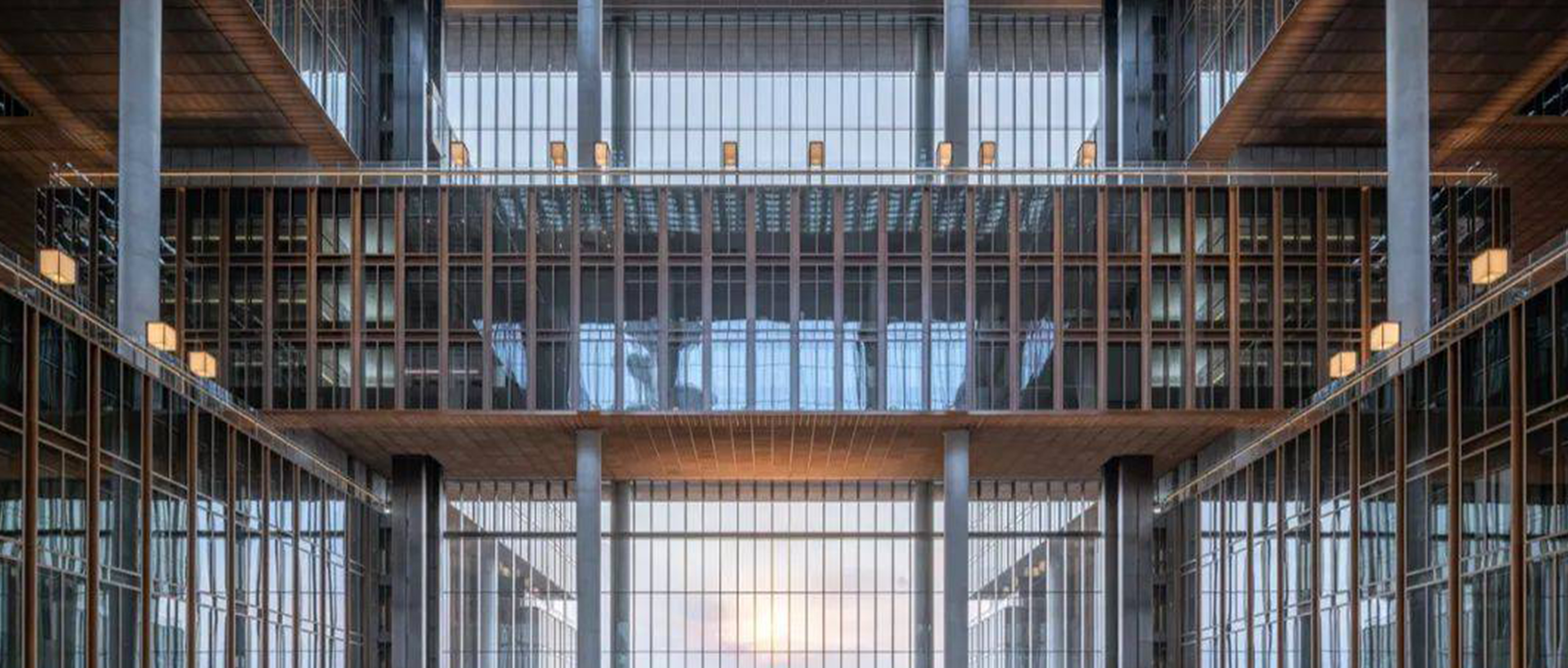
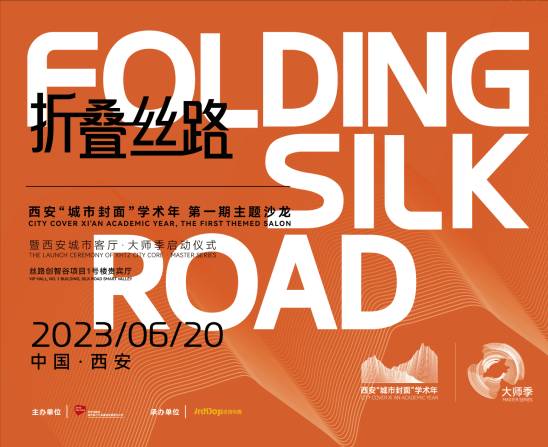
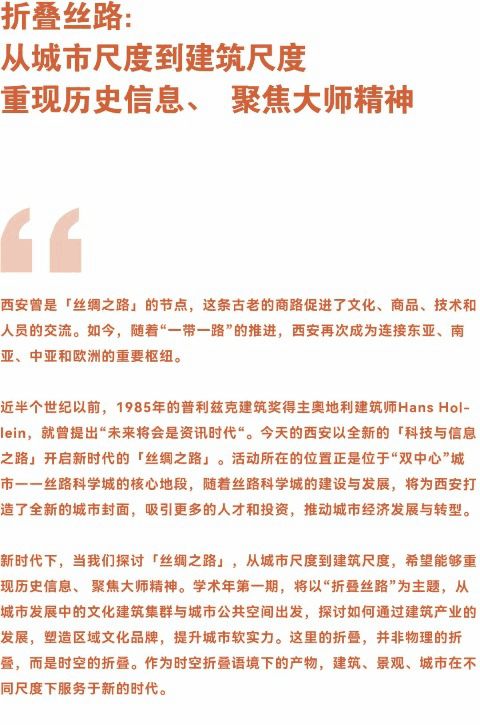
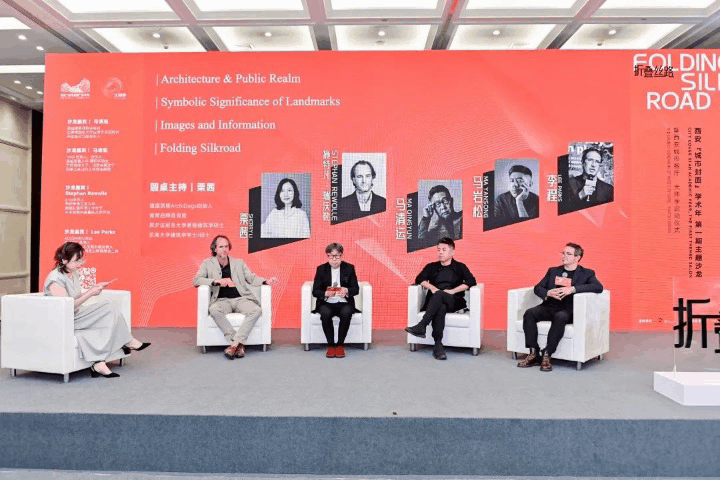
西安沙龙活动现场
本期嘉宾 丨 Stephan Rewolle
gmp合伙人
德国布伦瑞克工业大学
奥地利格拉茨工业大学
哥本哈根丹麦皇家艺术学院
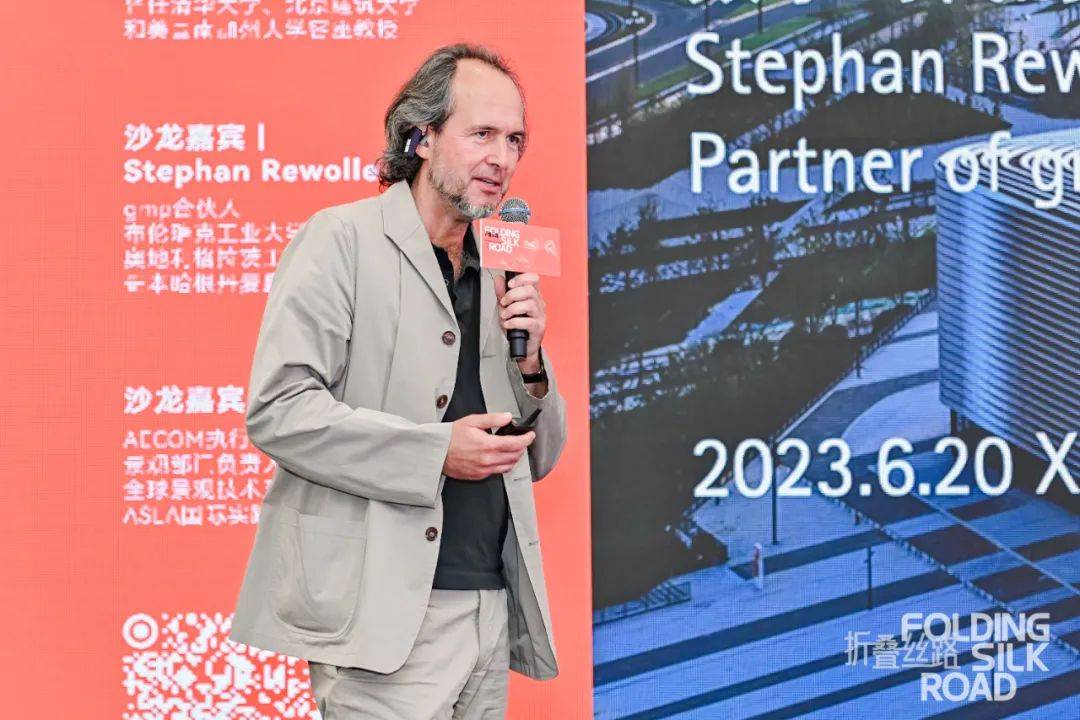
施特凡·瑞沃勒(Stephan Rewolle)于2021年成为gmp·冯·格康,玛格及合伙人建筑师事务所合伙人,负责gmp北京办公室的工作。瑞沃勒曾就读于德国布伦瑞克工业大学、奥地利格拉茨工业大学及哥本哈根的丹麦皇家艺术学院。他在gmp主持设计了许多知名项目,其中包括北京中国国家博物馆、北京丰台火车站、亚洲金融大厦暨亚投行总部、上海外滩SOHO、北京CHAO酒店、成都东安湖体育公园、天津国家会展中心、天津滨海文化中心等。
嘉宾分享 / “数字时代的建筑”
gmp / Stephan Rewolle
在虚拟时代的去物质化世界中,建筑作为一种物质属性的存留应如何放大物理体验的吸引力。本次演讲希望通过三个项目——成都东安湖体育公园、亚洲金融大厦暨亚投行总部和CHAO酒店来阐述建筑对数字时代的不同回应:带有数字化特征的建筑外观与建筑空间,以及建筑在数字媒介中的呈现。
01
世界大学生运动会新比赛场馆
东安湖体育公园
-
项目介绍
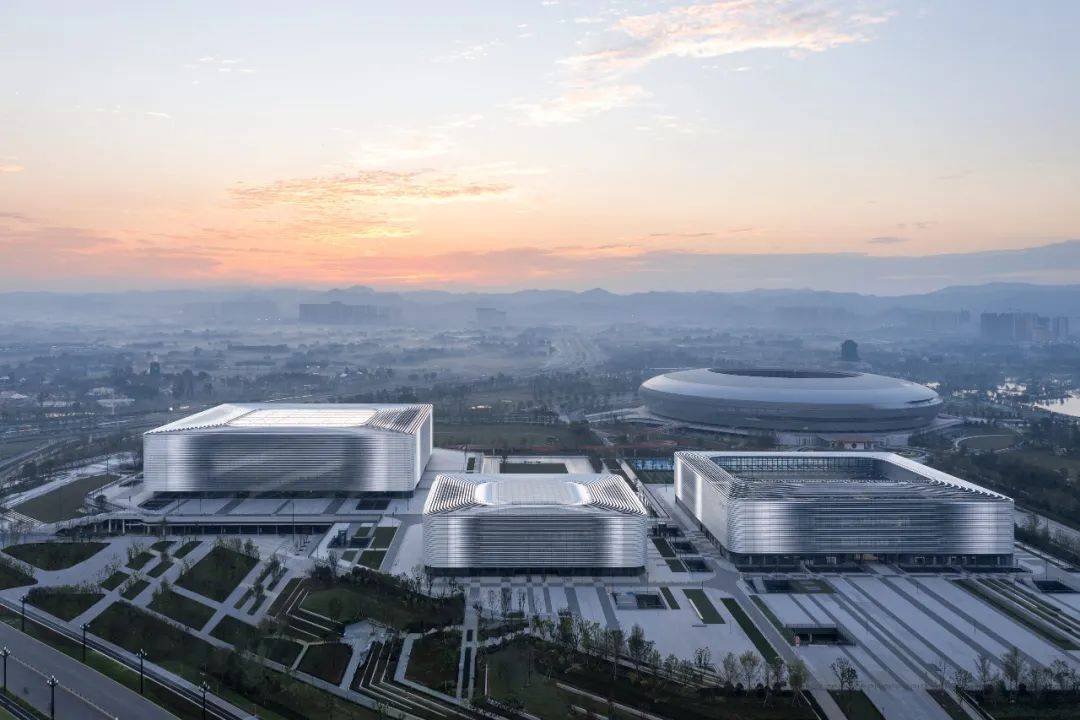
体育公园鸟瞰 ©CreatAR Images
2018年,gmp·冯·格康,玛格及合伙人建筑师事务所一举夺魁,赢得了东安湖体育公园三馆的建筑设计竞赛。现已建成的建筑群包括三座新的体育和休闲运动场馆,并将成为下一届世界大学生运动会的比赛场地。
After winning the competition in 2018, the architects von Gerkan, Marg and Partners (gmp) have completed the Chengdu Sports Center (also known as Dong’an Lake Sports Park), an ensemble consisting of three new sports and leisure buildings in the Chinese metropolis Chengdu. It will be the venue for the coming FISU World University Games.
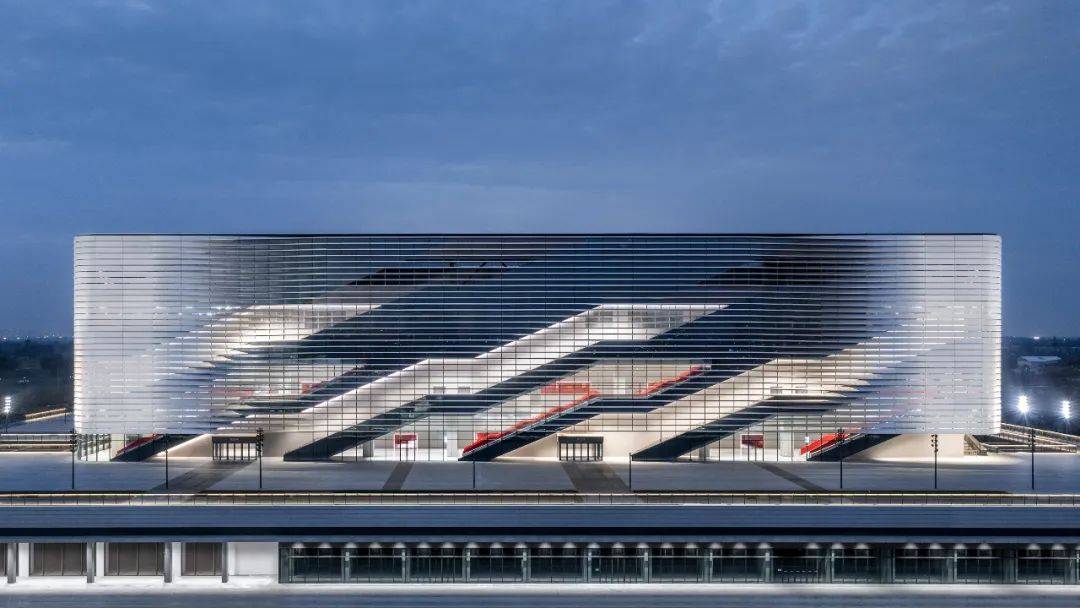
多功能体育馆立面夜景 ©CreatAR Images
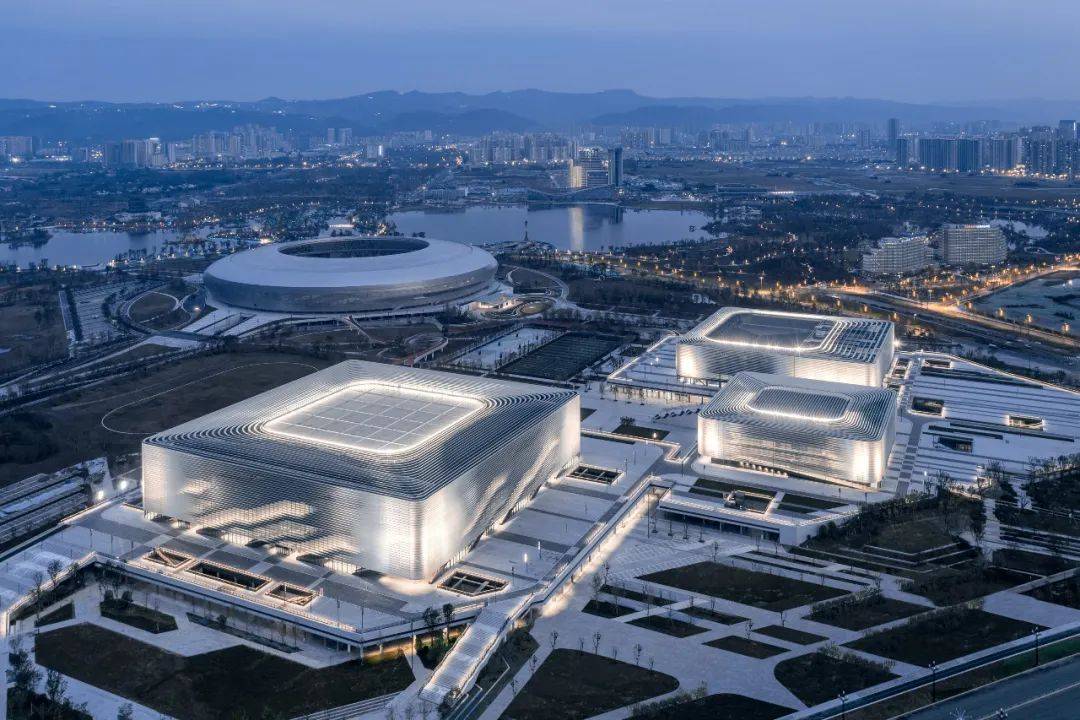
体育公园鸟瞰夜景 ©CreatAR Images
新的大运公园作为“东安新城”的核心项目,地处成都市中心以东龙泉驿区核心地带。三座体育馆围绕着场地内的中央广场组团布局。其中一座多功能体育馆可容纳1.8万观众,小球馆集文化、休闲和大众健身于一体,游泳跳水馆配有两片50米长的标准泳池、跳水池以及围绕中央活力广场布置的健身中心。
The new sports center will become the focal point of Dong’an New Town – an area situated by the water to the west of the city center, in the heart of the Longquan district. The ensemble comprises a group of buildings around a central plaza, consisting of a sports hall with 18,000 seats, a multifunctional hall for culture, leisure, and popular sports, as well as an indoor pool complex with two 50-meter swimming pools.
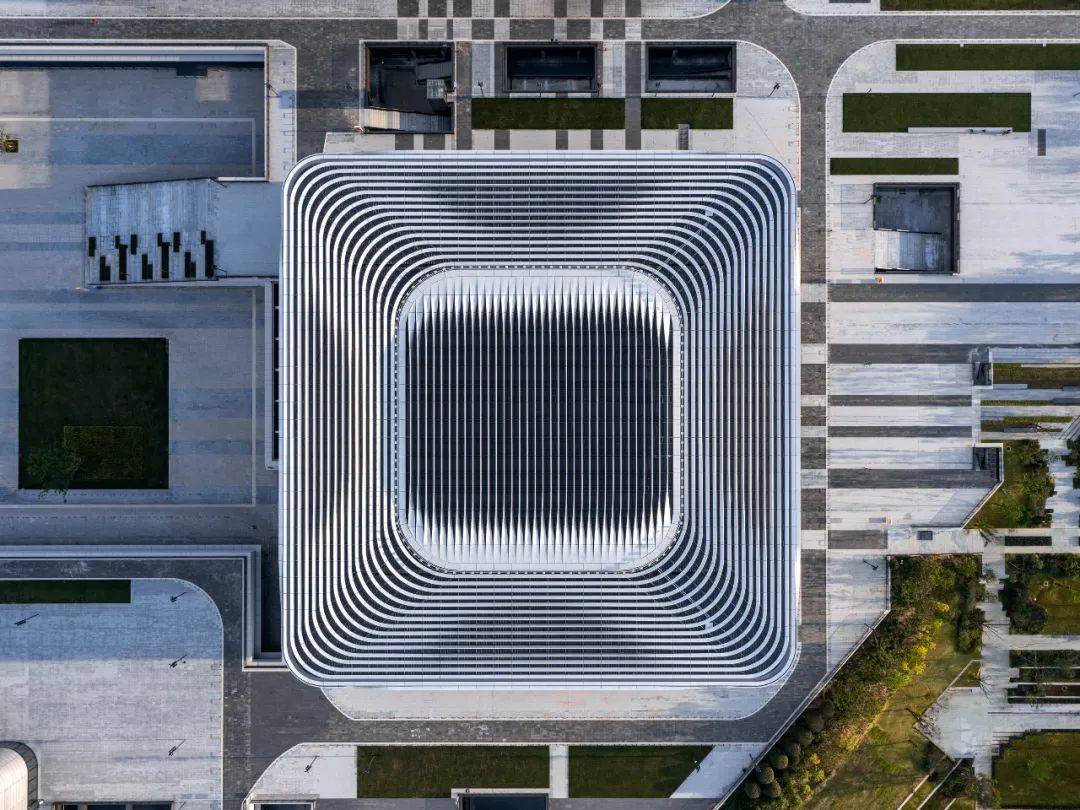
小球馆屋顶鸟瞰 ©CreatAR Images
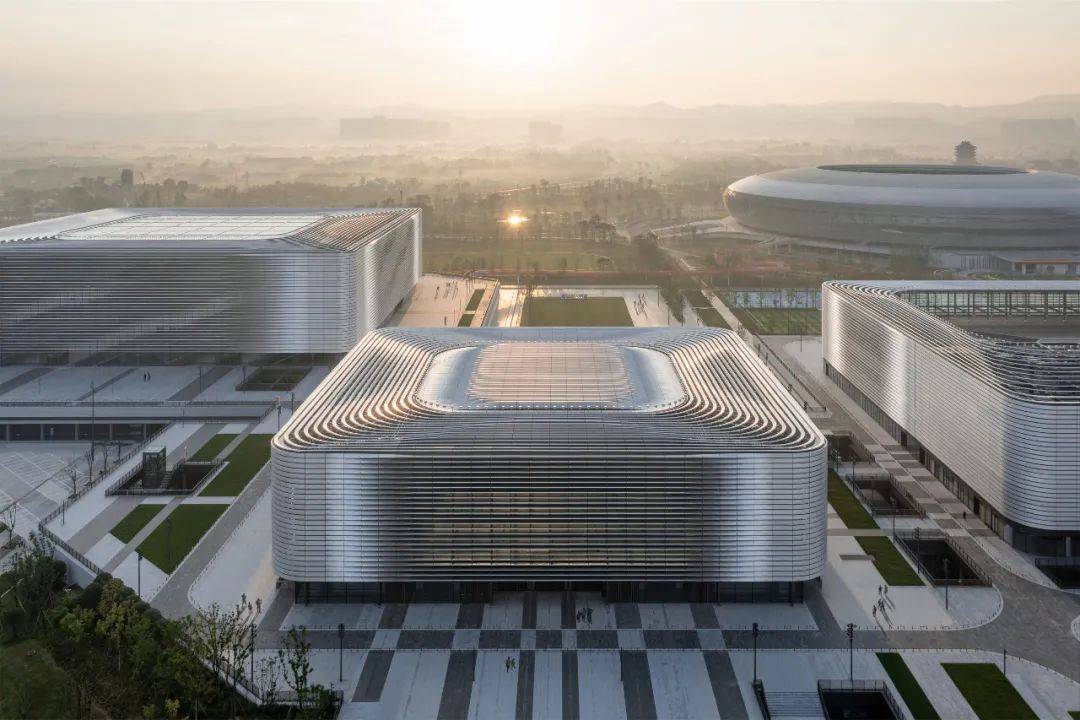
体育公园鸟瞰局部 ©CreatAR Images
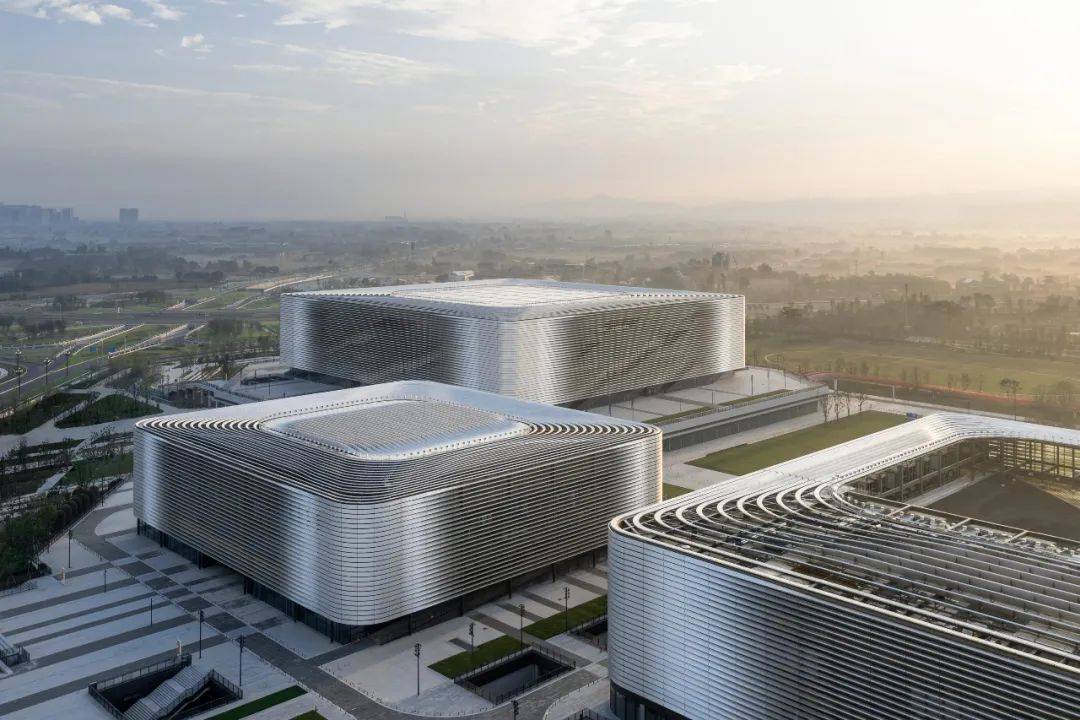
体育公园鸟瞰局部 ©CreatAR Images
这三座体育馆在平面上呈正方形,由一个共同的基座相连。篮球、乒乓球和羽毛球等室内训练设施以及餐厅、商店和停车场面向开放式广场布置。由银色铝制元素构成的百叶幕墙使建筑群从远处看极为耀眼。银色铝百叶朝幕墙中心方向逐渐翻转打开,展现出内部不同功能空间的形态及颜色。每座建筑都有自己的颜色代码,便于访客在场地及体育馆内辨认方位。幕墙的百叶结构在屋顶上得以延续。这样一来,技术性的屋顶结构被封闭起来,从空中俯视也可以清晰辨别建筑群的标志化设计语言。建筑与基座之间的玻璃幕墙向内退进,形成了各个建筑单体的入口区。
The three buildings each feature a square footprint and are linked via a shared plinth which, towards the open courtyard area, accommodates indoor training facilities for basketball, table tennis, and badminton, as well as restaurants, shops, and parking. The ensemble can be seen from afar owing to the louver-style facades with folded, shiny silver aluminum elements turning towards the center of the facade, thereby revealing the form and color of the externally placed escape stairwells. Each building has its own color code that facilitates visitors’ orientation on the site and inside the halls. The louver structure of the facade continues on the roof as a fifth facade, which means that the technical structures on the roof are enclosed and the emblematic appearance of the ensemble remains visible also from above. The entrance zones of each building are marked by narrow recesses.
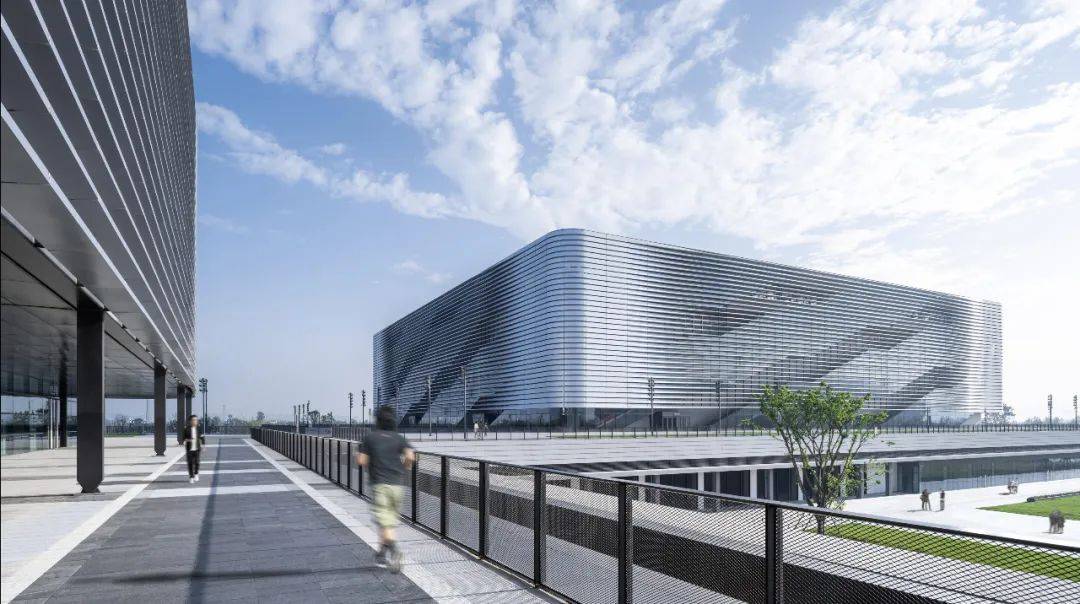
体育公园共享平台 ©CreatAR Images
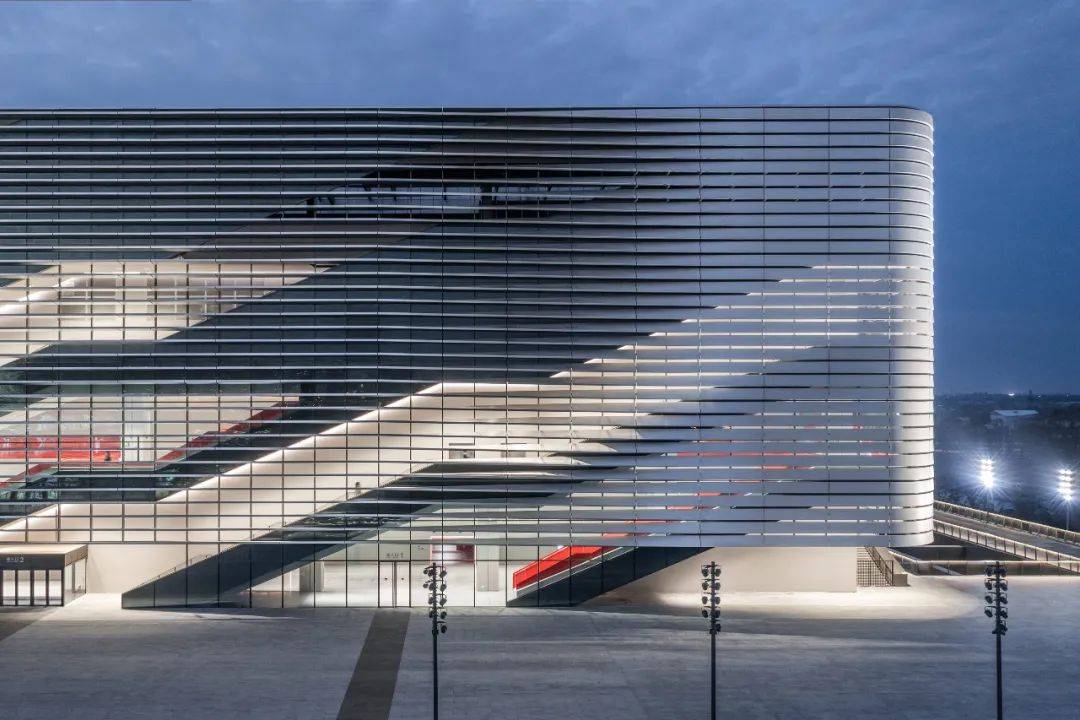
多功能体育馆立面夜景 ©CreatAR Images
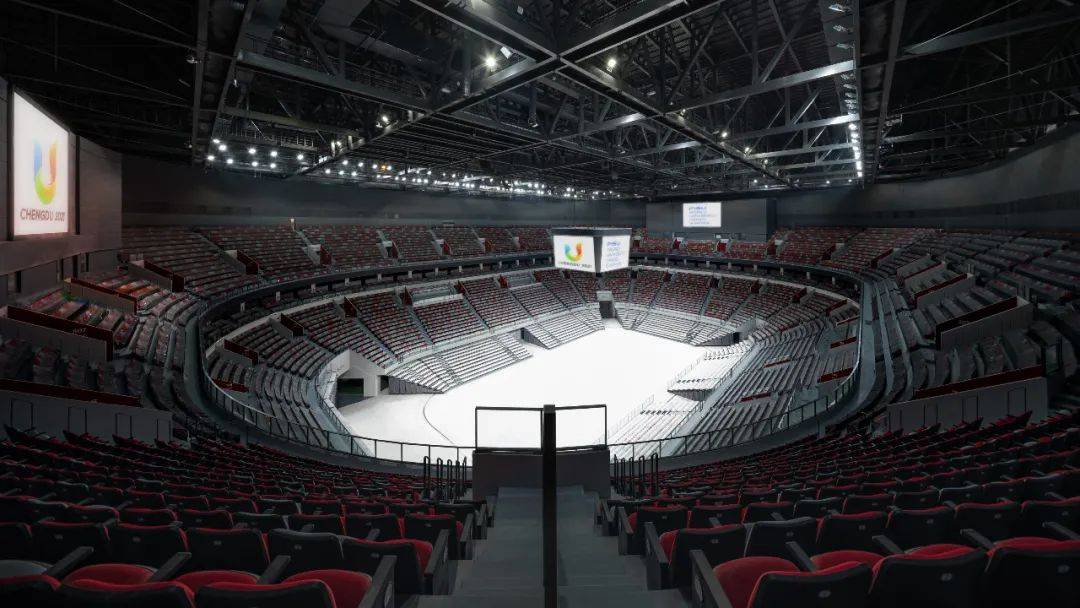
多功能体育馆室内空间 ©CreatAR Images
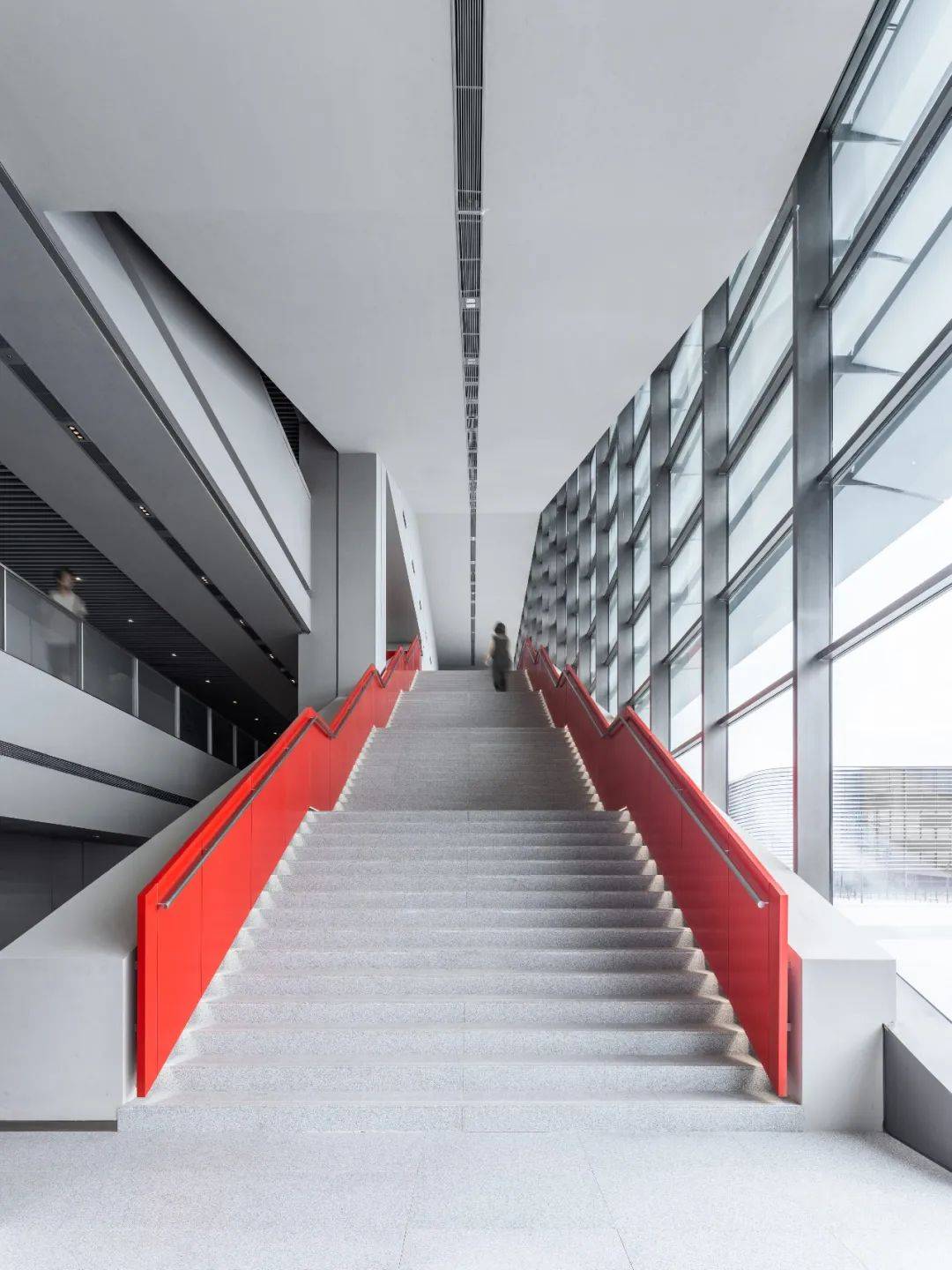
多功能体育馆室内楼梯 ©CreatAR Images
场地的北边和西边毗邻两条主要城市交通干道。在城市规划方面,东安湖体育公园的设计便于访客从交通干道上直达公园场地。同时,三座建筑的布局呈犄角之势,并在邻近体育场的配合下为建筑群创造了充满互动性的室内和室外空间。安静的室内区域为会面和健身提供了场所。最终,呈现给大众的是一个多样化的功能组合建筑,既为专业竞技和大众体育提供训练机会,同时也为成都提供一个新的休闲场所。
Two large urban traffic axes border the site to the north and west. In terms of urban design, the Dong’an Lake Sports Park accommodates this situation by guiding its visitors from there directly to the site. At the same time the ensemble creates interesting interior and exterior spaces through the offset arrangement of the three buildings in conjunction with the neighboring stadium. The calm interior provides spaces for meeting and for movement. This creates a diverse functional mix, with training facilities for performance and popular sports as well as a new social meeting place for the Longquan district.
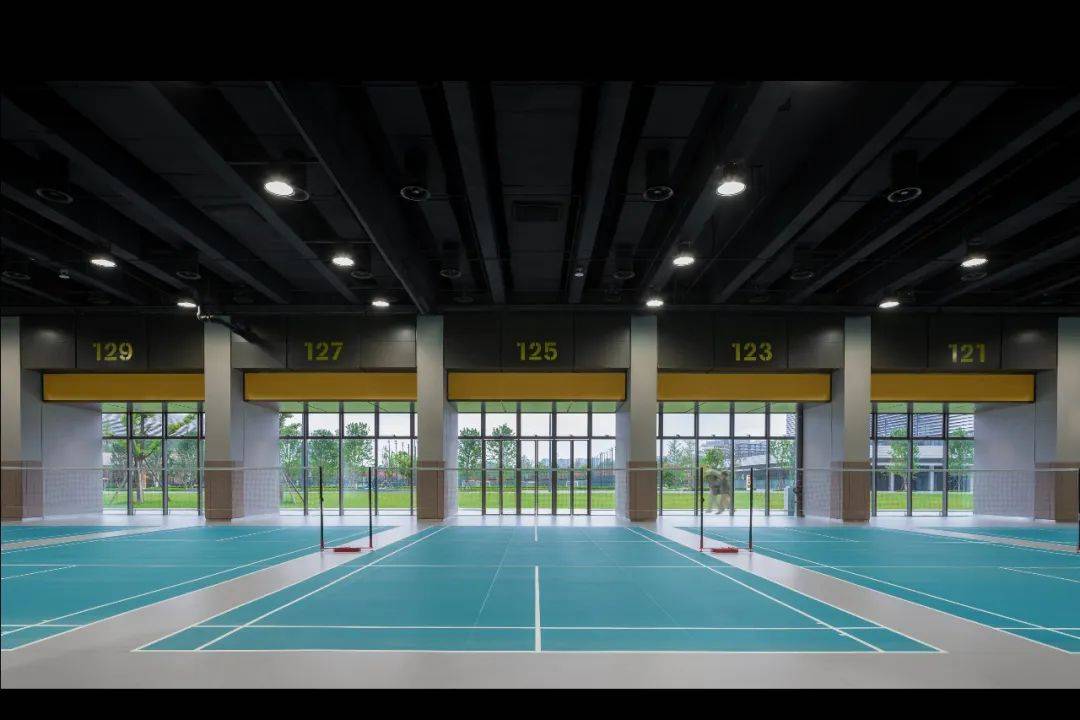
大平台室内空间 ©CreatAR Images
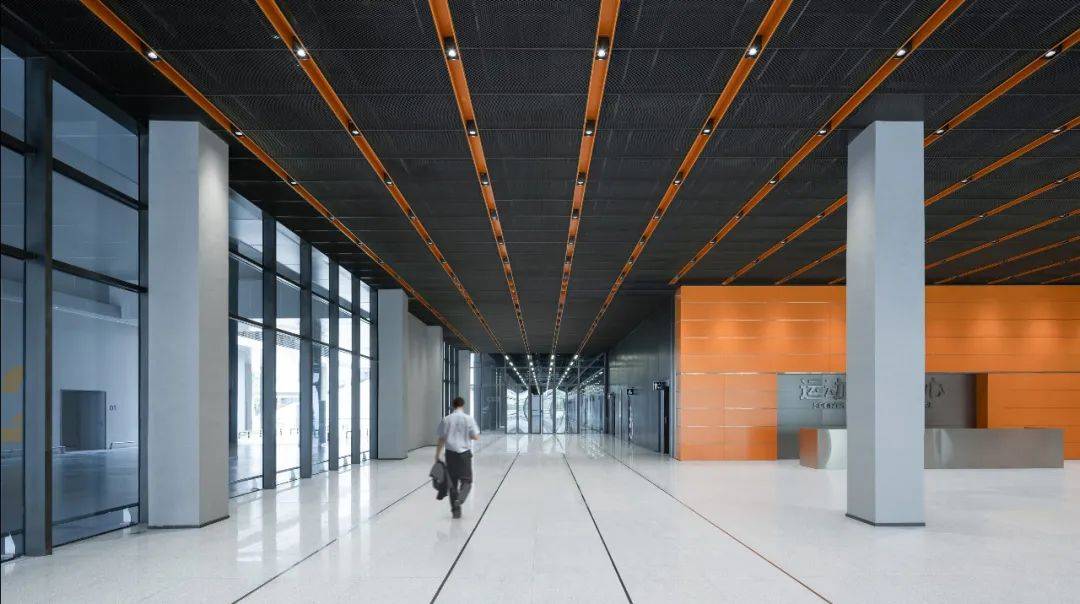
大平台室内空间 ©CreatAR Images
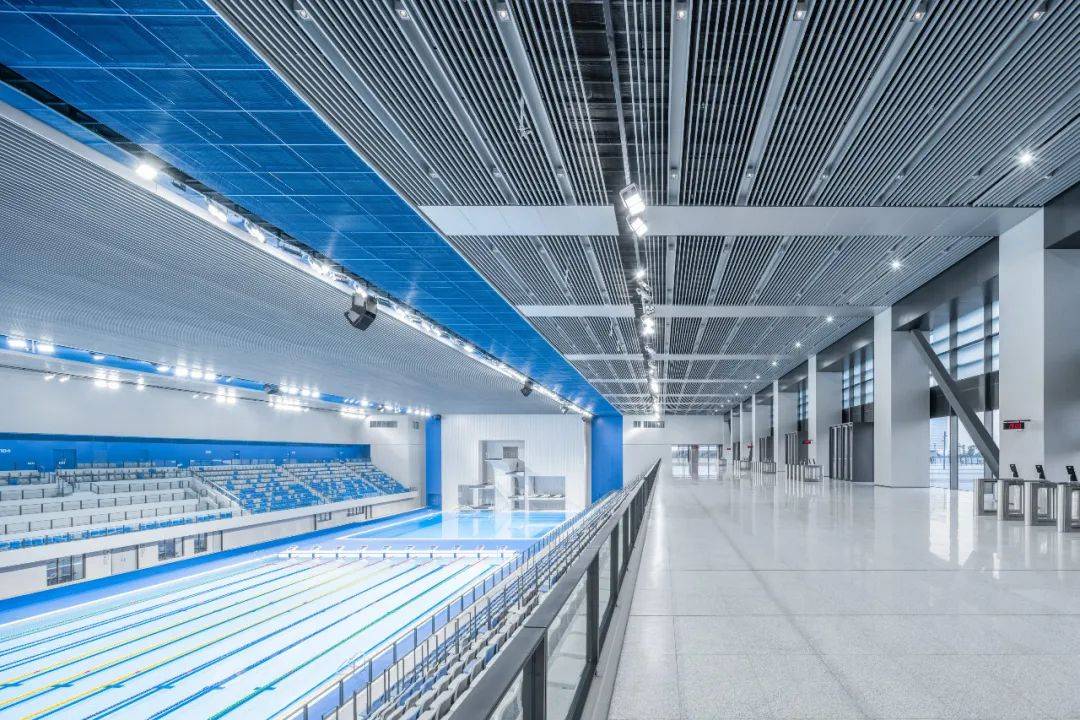
游泳跳水馆室内空间 ©CreatAR Images
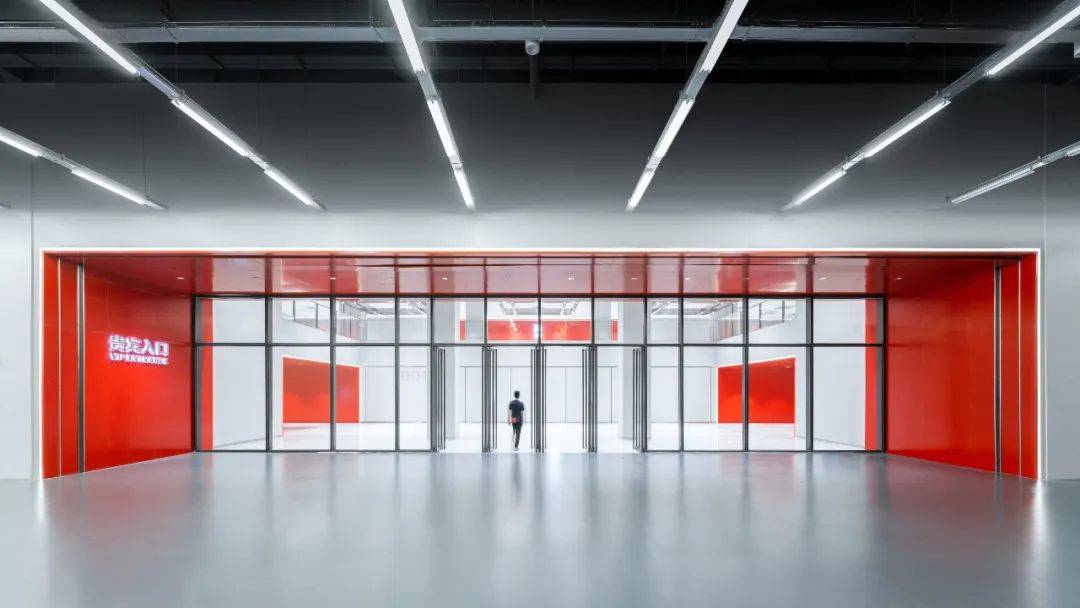
多功能体育馆贵宾入口 ©CreatAR Images
-
项目信息
设计竞赛:2018年,一等奖
设计:曼哈德·冯·格康和施特凡·胥茨以及施特凡·瑞沃勒
项目负责人:隋锦赢
中国项目管理:吴镝,林巍,王征
竞赛阶段设计团队:黄晗,李然,马源,王妍,翟骋骋,Jan Peter Deml,杨枫,袁涛
实施阶段设计团队:黄晗,李然,马源,Maarten Harms,Mulyanto,王妍,夏菁,翟骋骋,朱世游,Jan-Peter Deml,杨枫,袁涛
中方合作设计:中国建筑科学研究院有限公司,中国建筑西南设计研究院有限公司
业主:华润置地(成都)发展有限公司
建筑面积:地上 152131平方米,地下 47286平方米
座席数:多功能体育馆 18000座席,游泳跳水馆 3000座席
02
亚洲金融大厦
暨亚洲基础设施投资银行总部
-
项目介绍
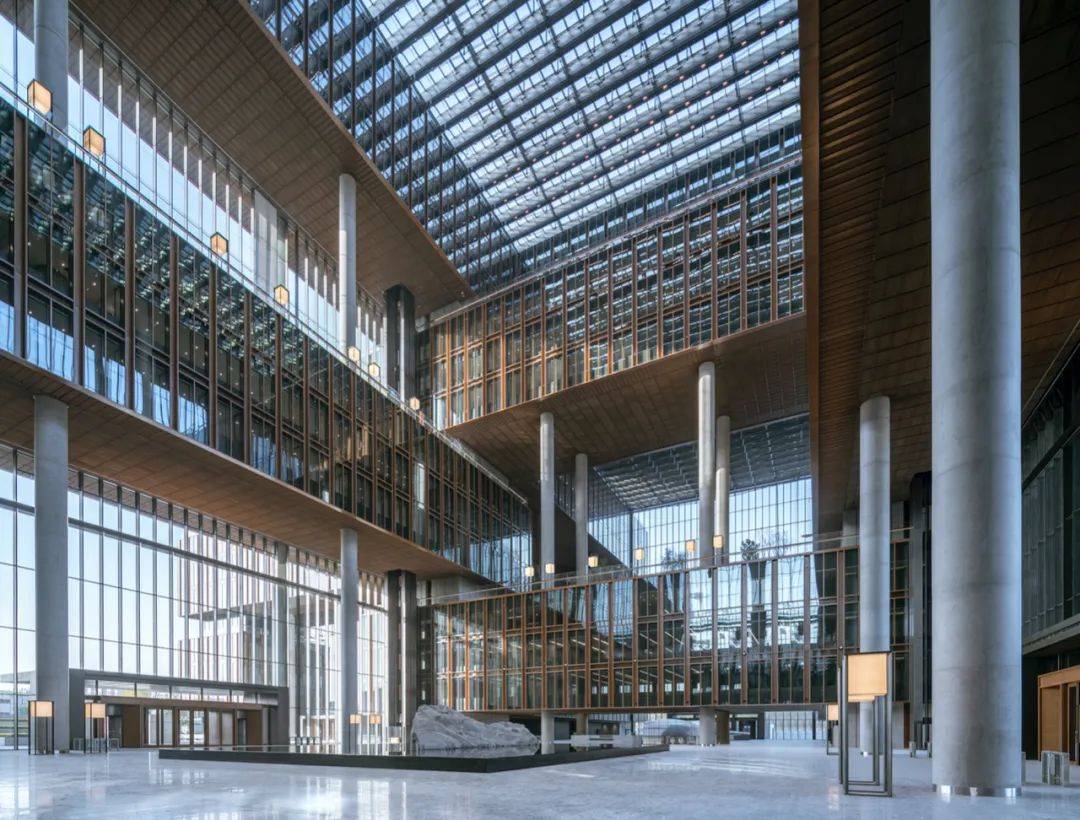
中央中庭内景 ©CreatAR Images
亚洲基础设施投资银行(亚投行)是第一家在中国设立的多边开发银行。目前,这一拥有103个成员国的金融机构正式迁至设在北京亚洲金融大厦内的新总部。亚洲金融大厦的建筑设计方案于2015年9月启动国际征集,gmp·冯·格康,玛格及合伙人建筑师事务所提出的“鲁班锁”设计方案最终获胜,后续与清华大学建筑设计研究院合作进行实施阶段设计。项目坐落在北京奥林匹克公园的中心区,地处北京南北中轴线北端,紧邻中国国家体育馆与中国国家会议中心等标志性建筑。这座高度为83米的对称建筑由叠落曲折的连续体量生长而成,所有办公空间围绕九个采光中庭组团布置,在中心形成挑空中庭,创造了一个具有开放交融空间和连贯视觉联系的建筑整体。
Asian Infrastructure Investment Bank(AIIB) is the first multilateral development bank with head office in China. This financial institution, with its 103 member states, has now moved into its new head office at a prominent location in Beijing. After winning the international competition in September 2015, the architects gmp von Gerkan, Marg and Partners and their partner practice Architectural Design and Research Institute of Tsinghua University Co. LTD. (THAD) have completed the 83-meter-high symmetrical building with its stacked meandering building volumes. It marks the end of the north-south axis through Beijing’s Olympic Park and is located in the direct vicinity of iconic buildings such as the National Stadium and the National Convention Center. All offices are grouped around a total of nine open courtyards that allow light into the building. Its center features a building-high atrium around which open spaces are arranged in a continuous manner offering many interconnecting views.
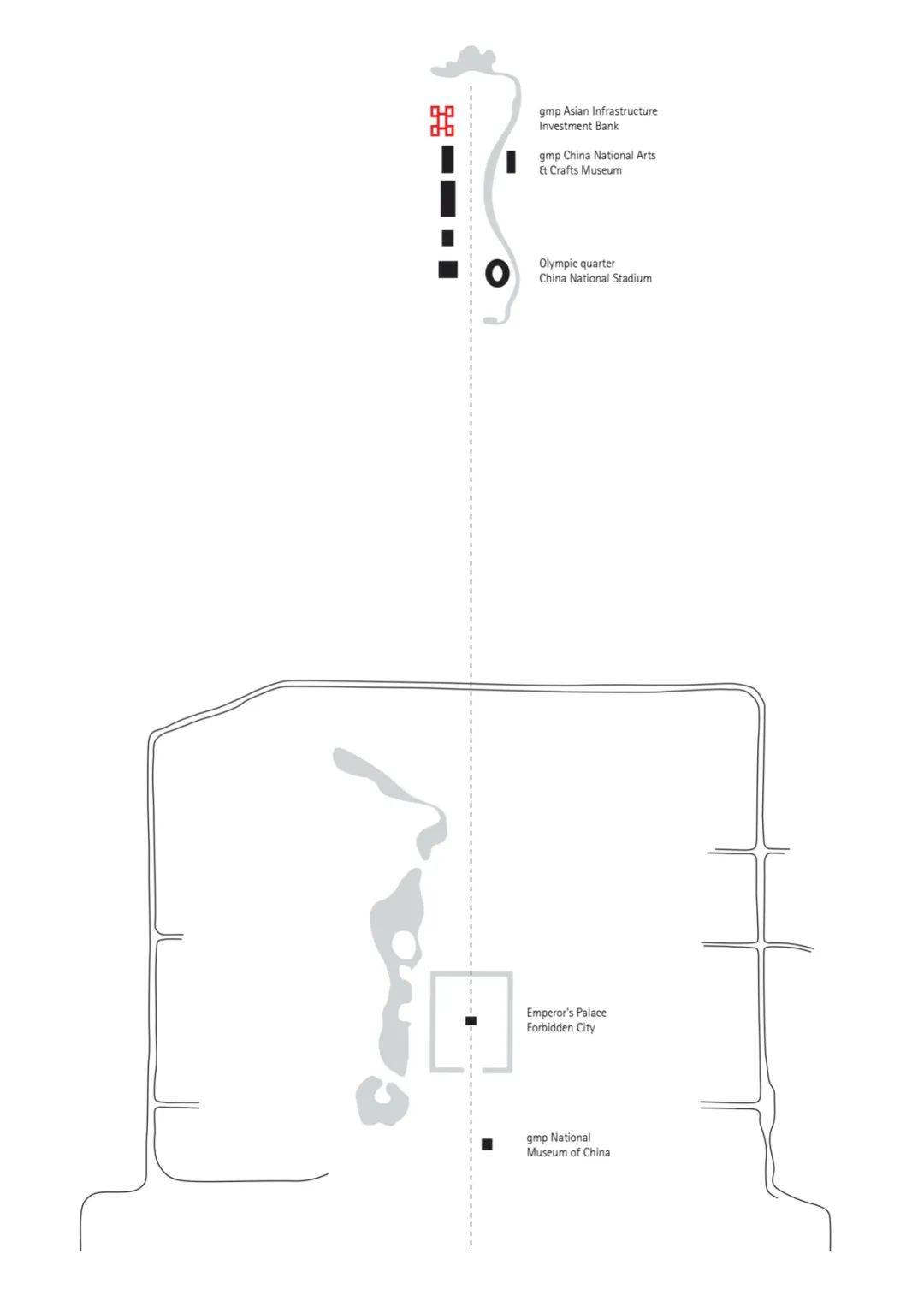
项目区位及北京城市中轴线示意图 ©gmp Architekten
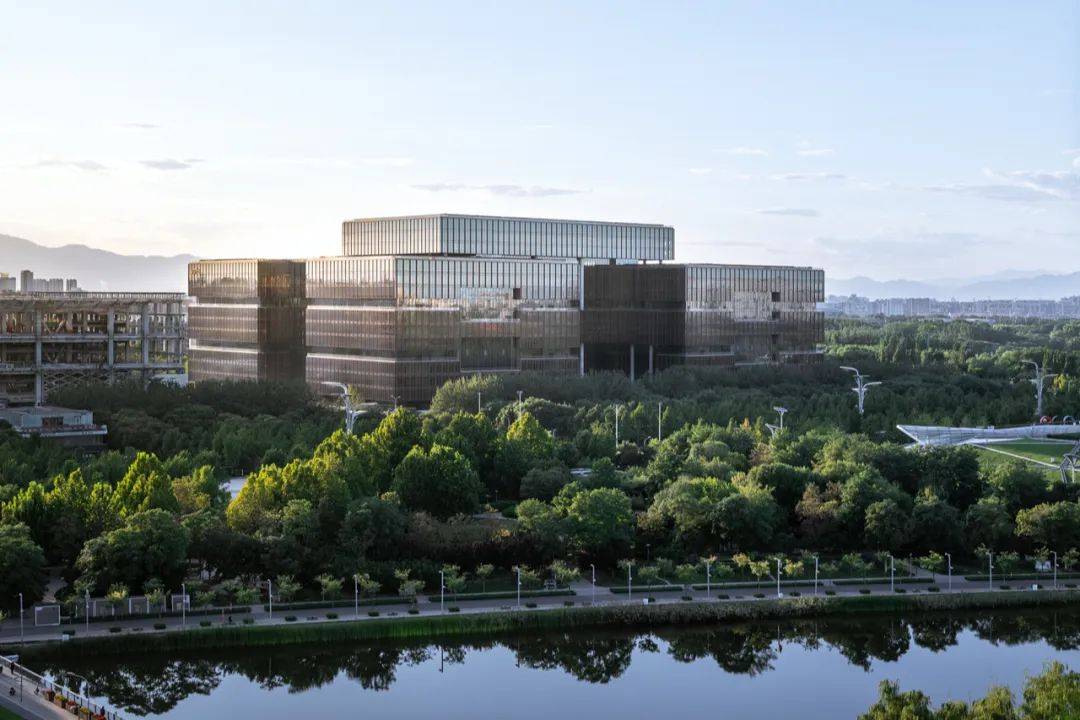
东南方向视角 ©CreatAR Images
建筑外观的设计理念基于具有北京古城典型风貌的院落逻辑,与中国传统的木构造形式相互呼应。每三层为一组的体量单元相互层叠、错落有致,这一设计手法打造了丰富而开放的内部景观,另外,工作环境的通透性亦彰显了亚投行逾百个国家交互包容、开放透明的合作理念。
In its exterior shape, the building adopts principles of the typical Beijing courtyard house, while its construction has elements that are reminiscent of traditional Chinese timber buildings. The stacked meandering three-story building volumes create a complex and open interior landscape that makes connections and emphasizes the transparency of the AIIB and the sense of community of the over 100 nations.
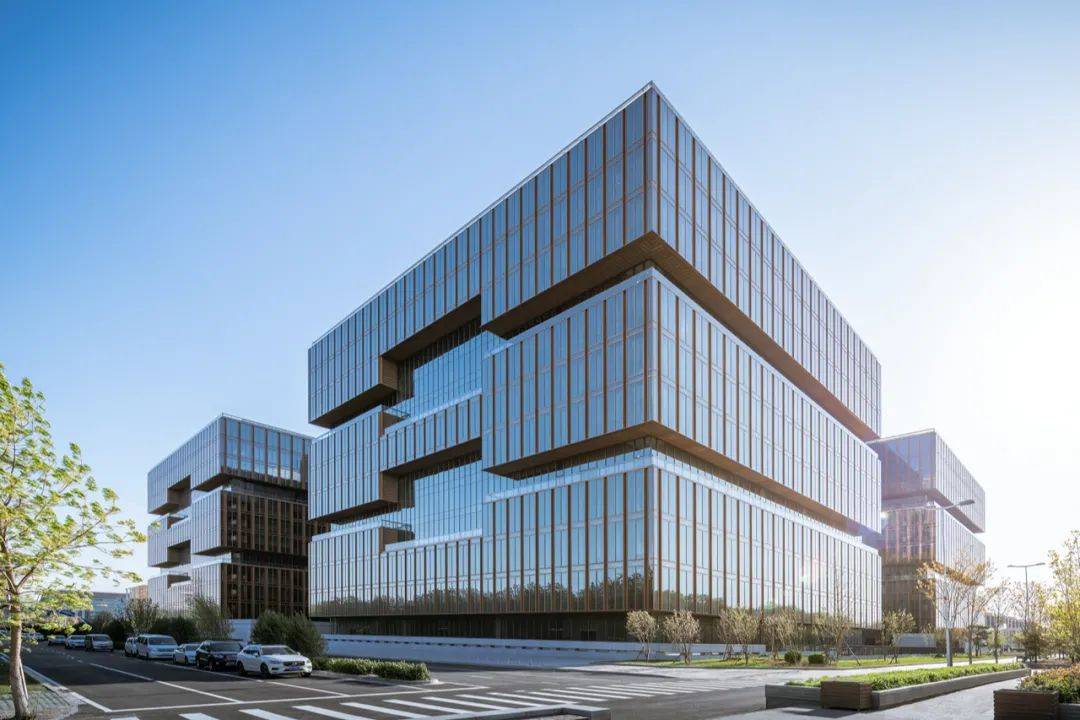
东北方向视角 ©CreatAR Images
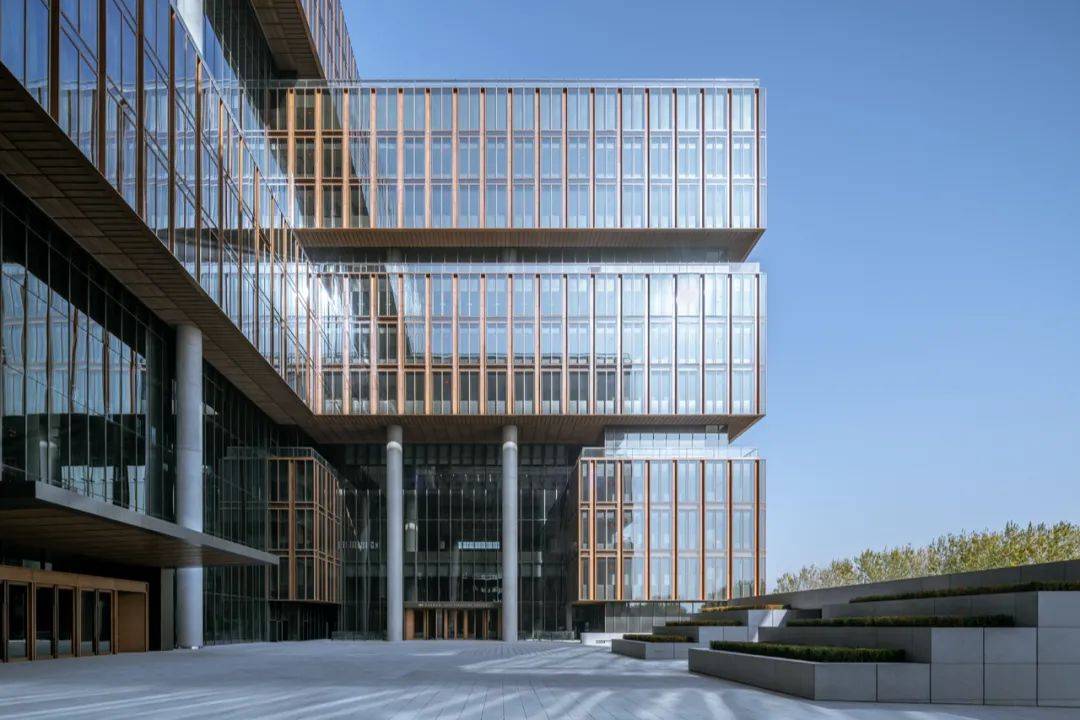
主入口广场 ©CreatAR Images

建筑体块叠加空间示意图 ©gmp Architekten
建筑首层与二层处设有共享的餐厅、咖啡馆以及拥有1500个座席的会议厅。此上的15层均为办公层,以模块化思路营造高品质办公单元。间隙楼层与空中花园从蜿蜒连续的回形布局中生成,采光中庭所创造的视野关系,可以提升公共空间的开放交流性,同时还赋予了建筑简明的朝向秩序。
The first floor and the first subfloor contain shared functions such as canteens, cafés and shops, as well as a conference hall for 1,500 delegates. The top fifteen floors accommodate offices in the form of modular work environments. Intermediate floors and open terraces are formed by the offset arrangement of the meandering parts of the building, offering many internal vistas and thus emphasizing the sense of community. At the same time, this structure makes orientation in the building straight forward.
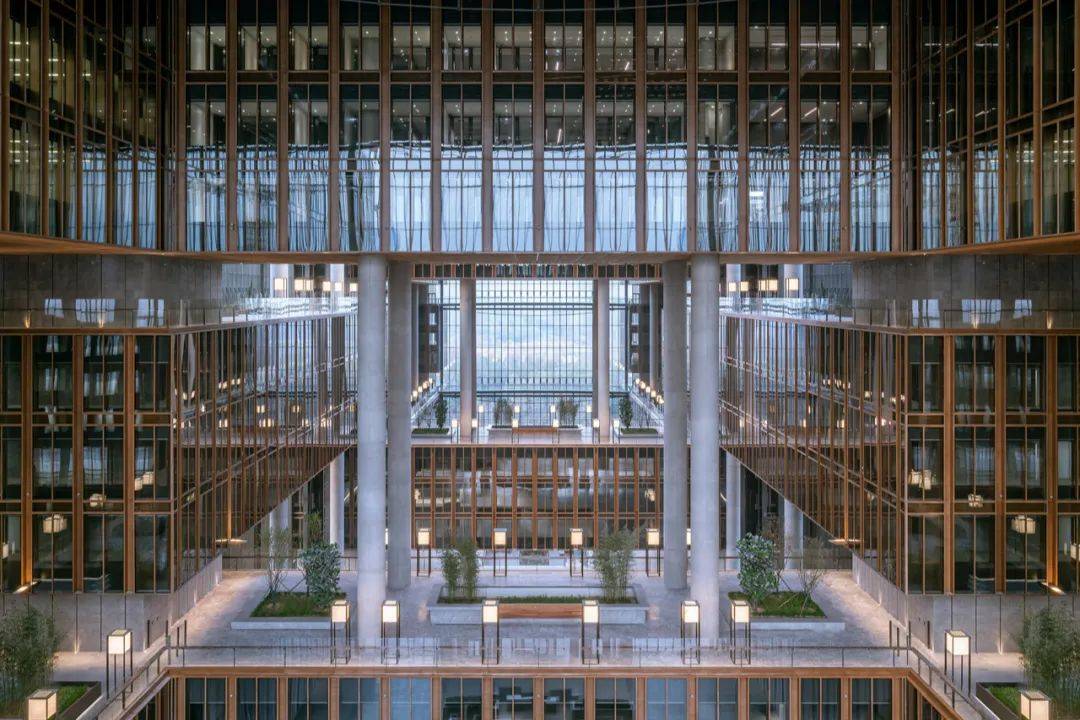
连续的开放空间 ©CreatAR Images
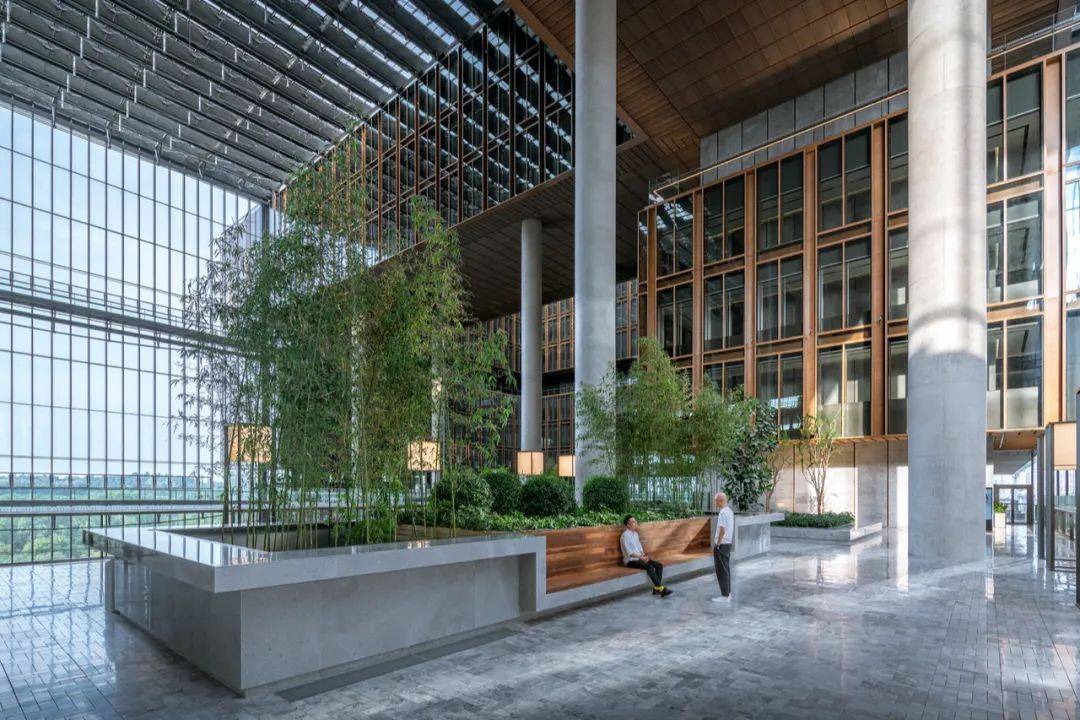
竹林采光庭院 ©CreatAR Images
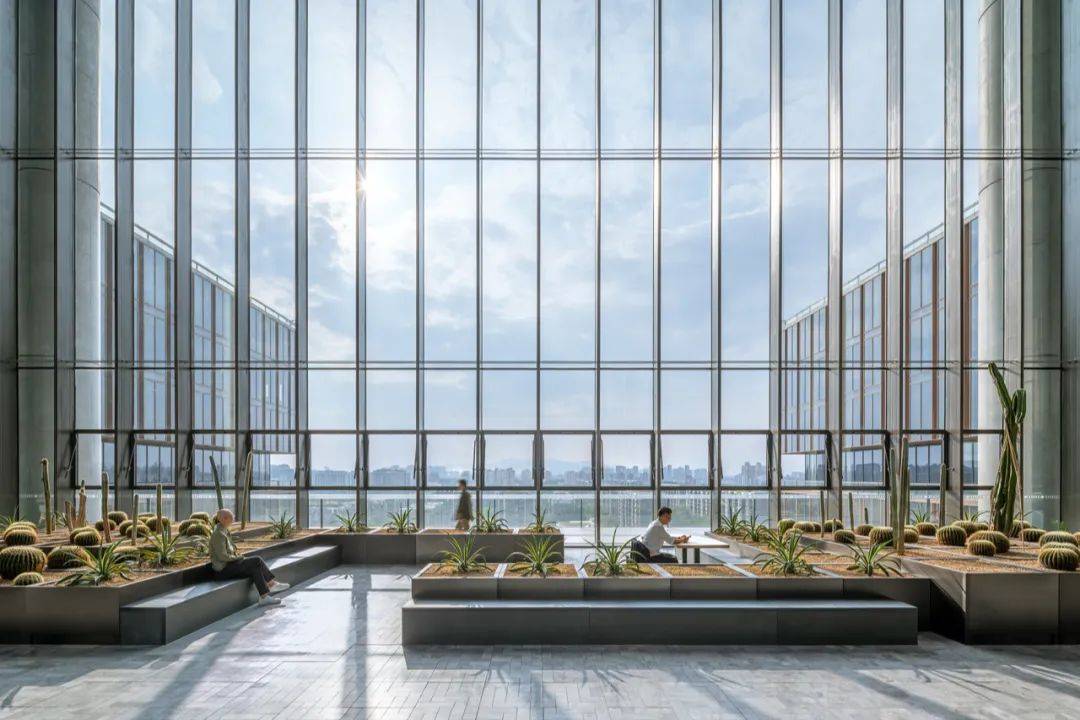
种植仙人掌的采光庭院 ©CreatAR Images
自然采光的空中花园依据不同主题设计了各具特色的植物景观,象征着丰富多元的“世界园林”:9个中庭中有3个采用了中国传统园林手法,此外还种植了一些来自亚洲成员国的树种。这一位处都市中央的“绿洲生态”为北京创造了一处彰显公共性的非正式互联场所,可举办各类活动。室内灯光设计犹如中国传统的灯笼意象,与木构件元素相辅相成,营造出温馨亲和的氛围。
Open sky decks with varied thematic planting symbolize the “gardens of the world”: three of the nine courtyards have been laid out in accordance with traditional Chinese garden design and, in addition, trees from Asian member states have been planted. These “oases” in the Beijing metropolis serve as informal, open meeting areas and can also be used for celebrations. Wooden elements, and lamps reminiscent of traditional Chinese lanterns, have been used to create an intimate atmosphere.
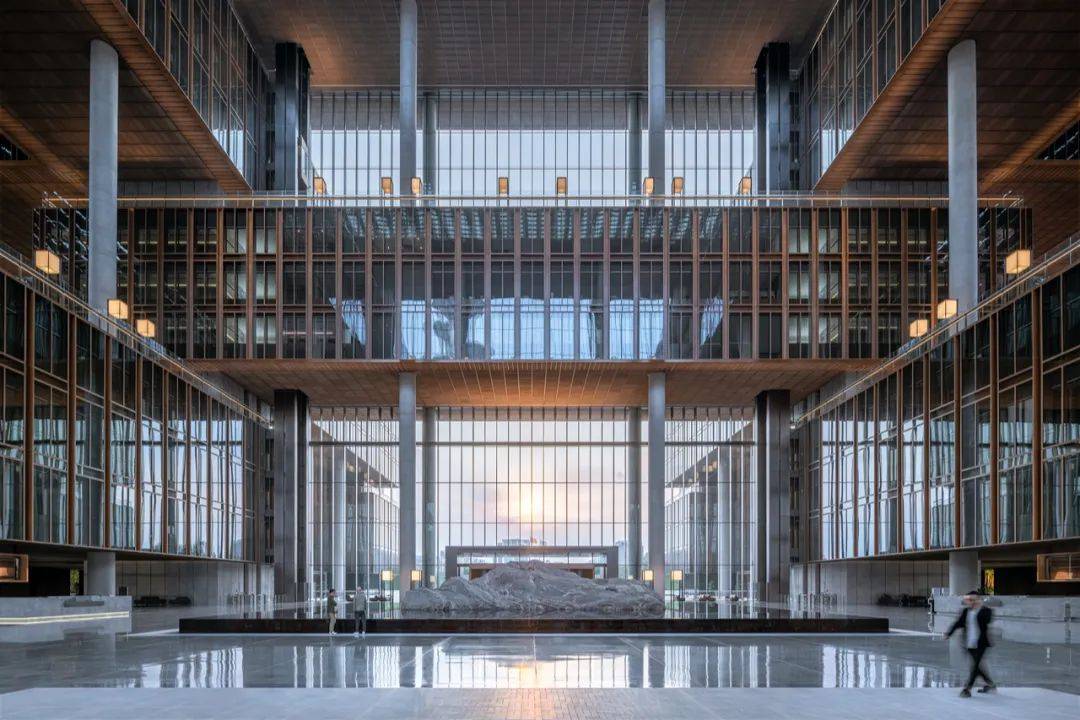
中央中庭内景 ©CreatAR Images
从外形观察,蜿蜒曲折的办公单元合为一体,生成一座方正庄重的玻璃体量,建筑主体再由四个朝向外侧的大厅进一步分解。建筑四面均设有一座中央大厅,形成面向各方的入口条件。在建筑立面表达上,三层一组的体量划分明晰可辨,通过向下投射的灯光设置突出点缀,与由内向外散发柔光的灯笼形象和谐统一。
Seen from the outside, the meandering building volumes make up a transparent glass cube that is structured and subdivided by the four external courtyard spaces. On each side of the building, in the middle, is a courtyard, thereby providing access to the building from all directions. The three-story elements that make up the whole building are expressed in the facade and are further highlighted by lighting that picks out the lower edges. The internal shimmering lanterns round off the harmonious lighting effect.
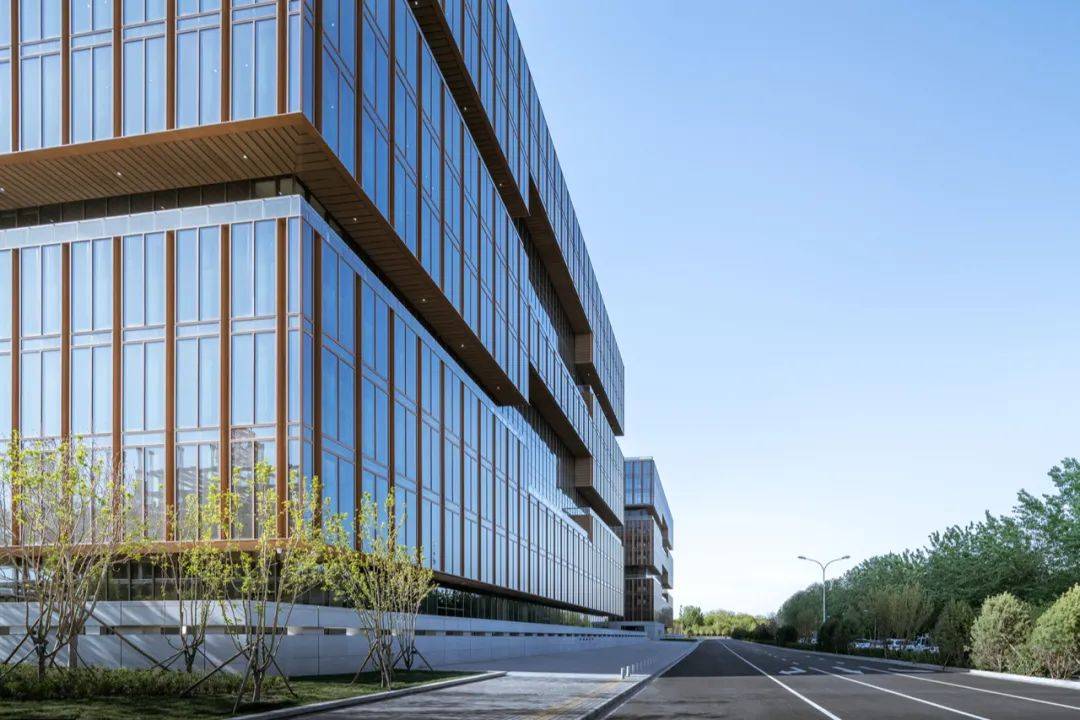
建筑立面局部 ©CreatAR Images
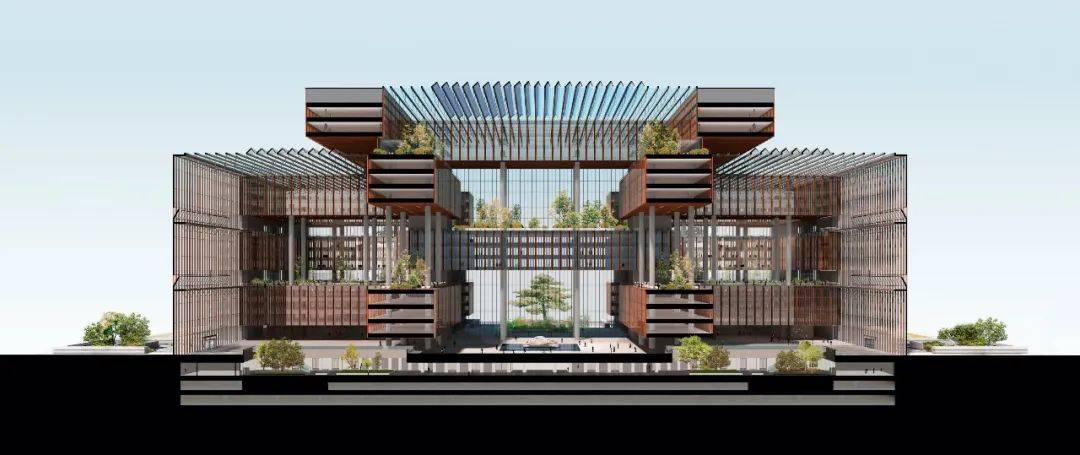
横剖面图 ©gmp Architekten
本项目的设计与实施历经四年时间,在紧凑高效的建设过程中实现了高水准的建筑品质。目前,该项目已取得国家绿色建筑最高级三星级认证设计标识证书,和LEED能源与环境设计先锋铂金级认证。
During the short design and construction period of only four years, it was possible to achieve the best possible standards in terms of ecological building. This is evidenced by the award of the national 3-star certificate, the top certification level for ecologically sustainable buildings in China, as well as that of the Platinum LEED certificate.
-
项目图纸
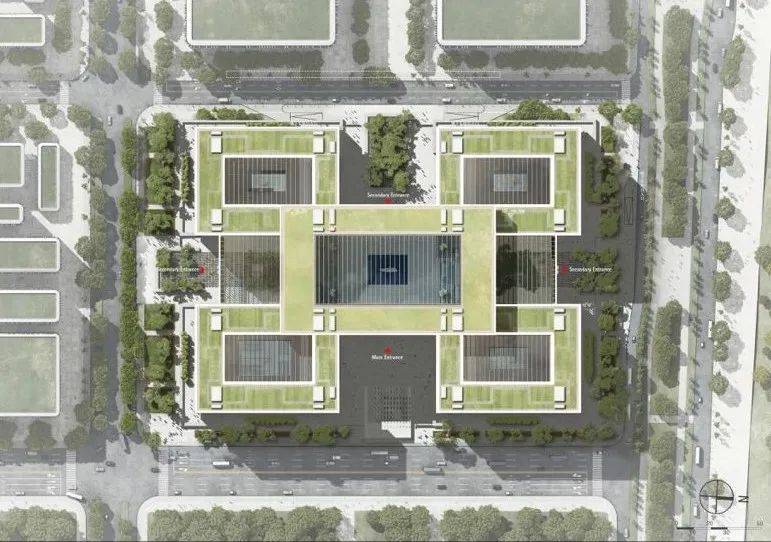
总平面图 ©gmp Architekten
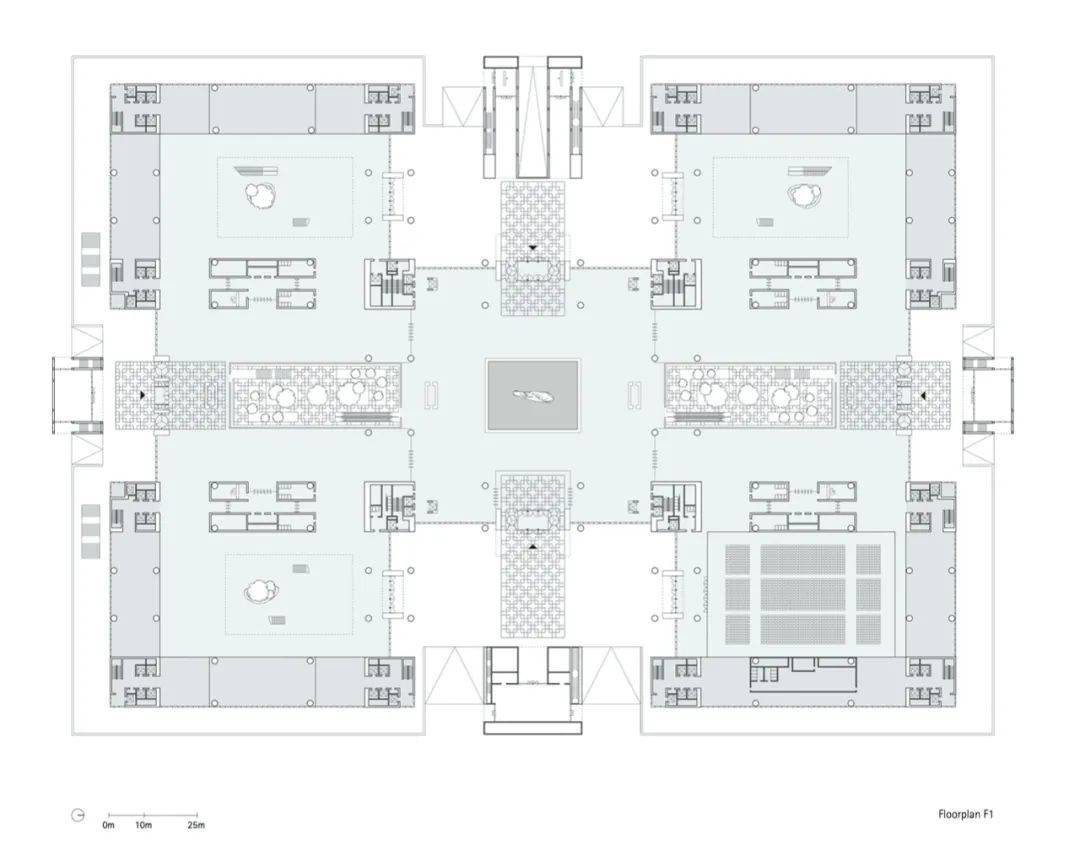
首层平面图 ©gmp Architekten
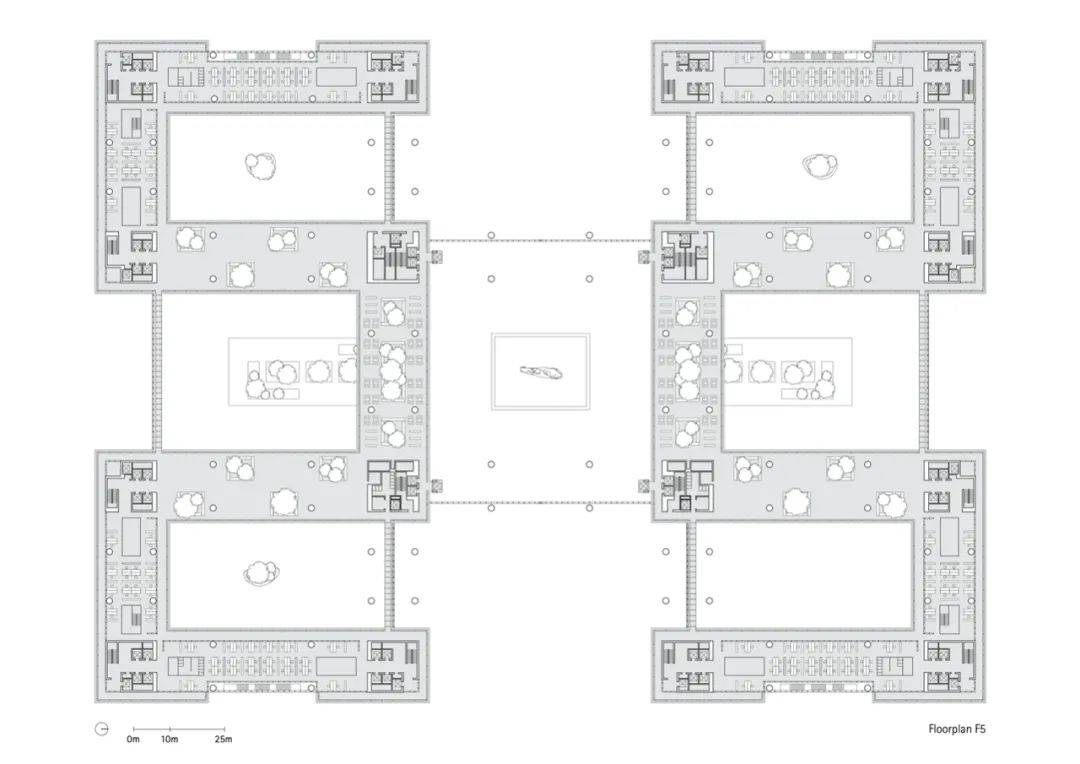
五层平面图 ©gmp Architekten
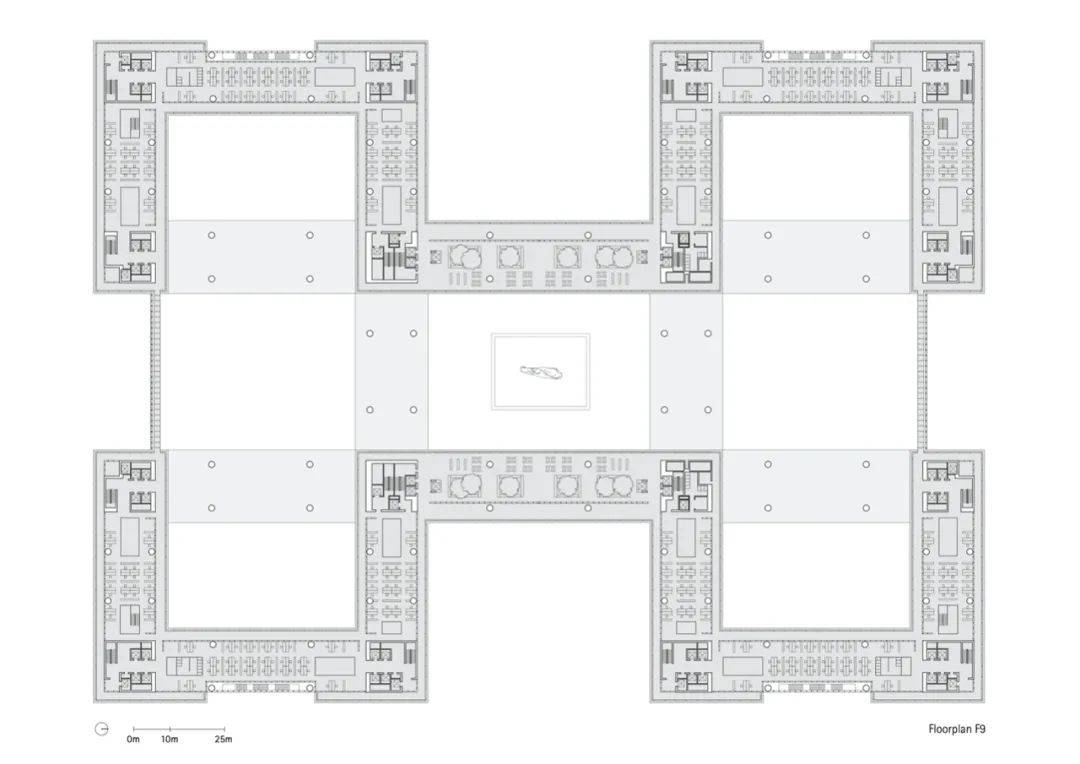
九层平面图 ©gmp Architekten
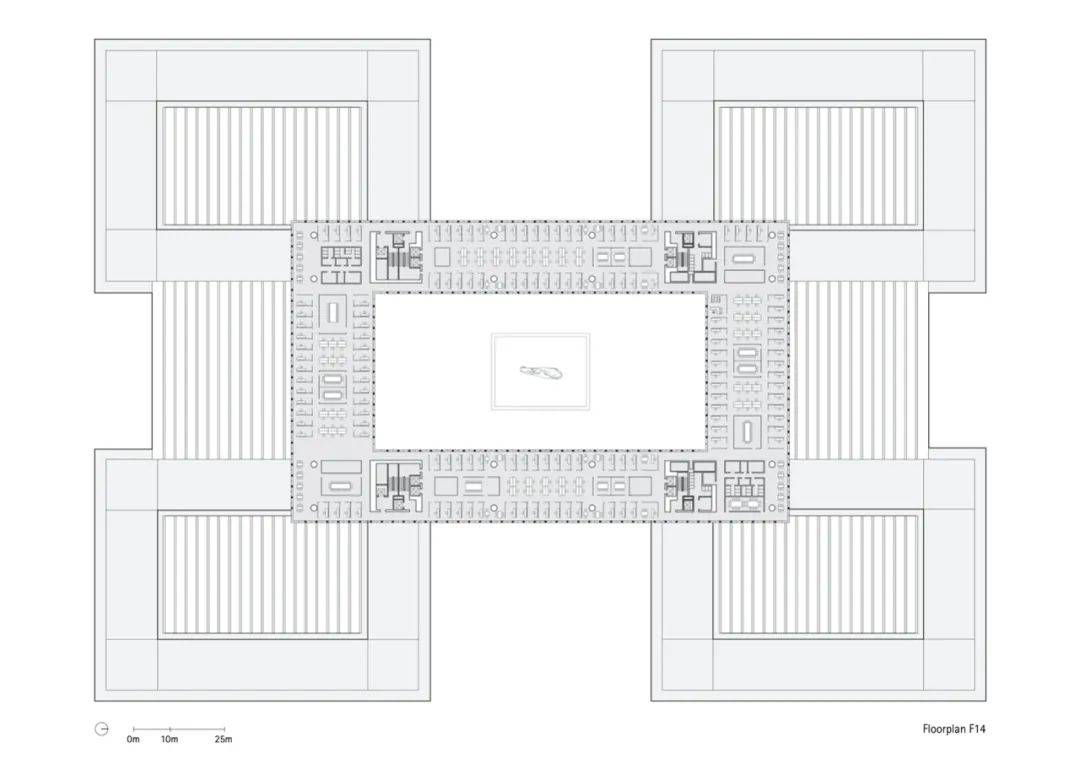
十四层平面图 ©gmp Architekten
-
项目信息
设计竞赛:2015年获胜方案
竣工时间:2019年
方案设计:曼哈德·冯·格康与施特凡·胥茨以及施特凡·瑞沃勒
项目负责人:苏俊
设计团队: 孔晶,赵琴昌,博彦·科切夫斯基,郭福慧,蒋昱程,王诗卉,安奈特·罗伯,杨莹,马源,黄菡, 提洛·切莫,袁涛,扬·皮特·德姆,杨枫
中国项目管理:李凌,解芳,易婷
业主:北京城市副中心投资建设集团有限公司
方案阶段
设计方:gmp·冯·格康,玛格及合伙人建筑师事务所
咨询顾问方:清华大学建筑设计研究院有限公司
初步设计阶段及施工图阶段
设计方:清华大学建筑设计研究院有限公司
咨询顾问方:gmp·冯·格康,玛格及合伙人建筑师事务所
结构设计:sbp 施莱希工程设计咨询有限公司,斯图加特
照明设计:Conceptlicht,特劳恩罗伊特
景观设计:WES 魏斯景观建筑,汉堡
幕墙顾问:迪索工程咨询(上海)有限公司
机电顾问:科进柏诚工程技术(北京)有限公司
标识设计:北京视域四维城市导向系统规划设计有限公司
建筑总面积:389972 平方米 (地上:256872 平方米,地下:133100 平方米)
03
北京三里屯
CHAO巢酒店更新改造
-
项目介绍
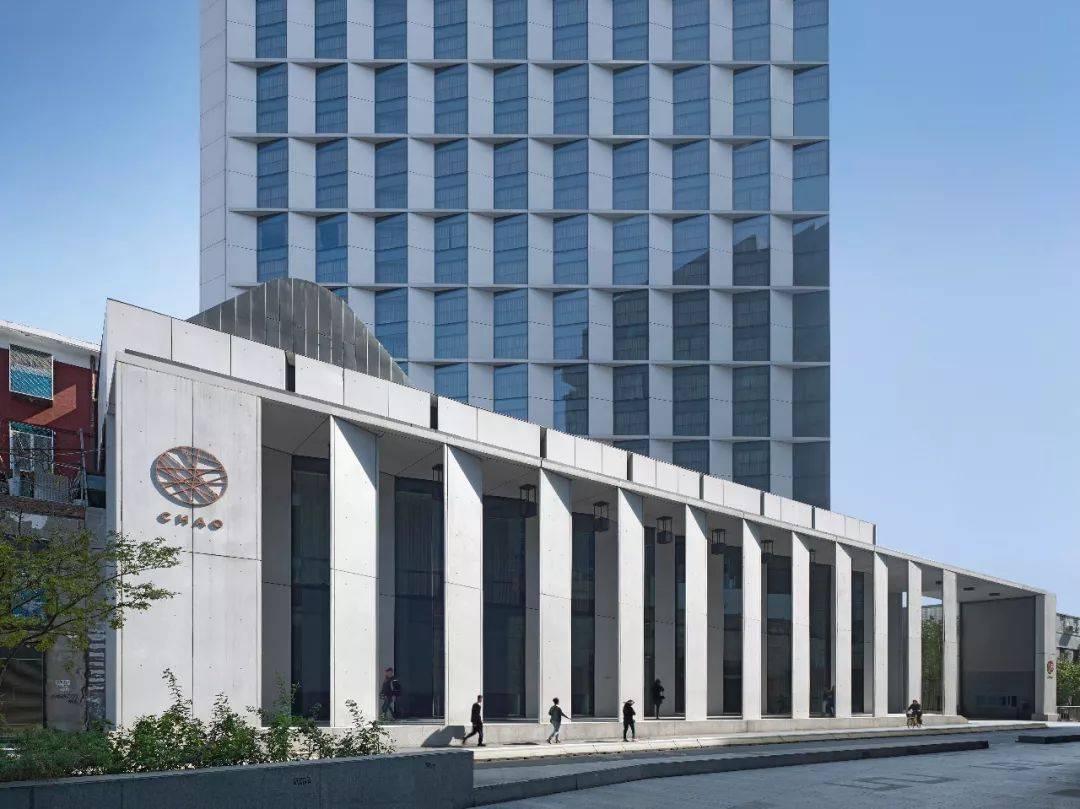
入口柱廊,酒店塔楼 ©Christian Gahl
北京三里屯CHAO巢酒店由gmp·冯·格康,玛格及合伙人建筑师事务所进行了现代化改造,改造后的酒店塔楼轻盈优雅,具有雕塑感,令人印象深刻。立面玻璃幕墙与混凝土构成的竖向折叠肌理虚实交替,产生特殊的光影效果,每两层为一单元的横向分隔,比例均衡。除外立面改造,同为gmp设计的多功能“日光礼堂”更为酒店增添了一个极具氛围感的活动空间。
The new facade by von Gerkan, Marg and Partners Architects (gmp) imparts a lightness and a sculptural effect to the modernized hotel tower, which can be seen from afar. Its angled vertical elements and the alternating closed and glazed panels create a play of light and shadow. Horizontal ledges are inserted every two stories, thus creating a calm facade geometry with balanced proportions. In addition to the external envelope, gmp designed the multifunctional “Glasshouse” to add a venue with a special atmosphere to the hotel complex.
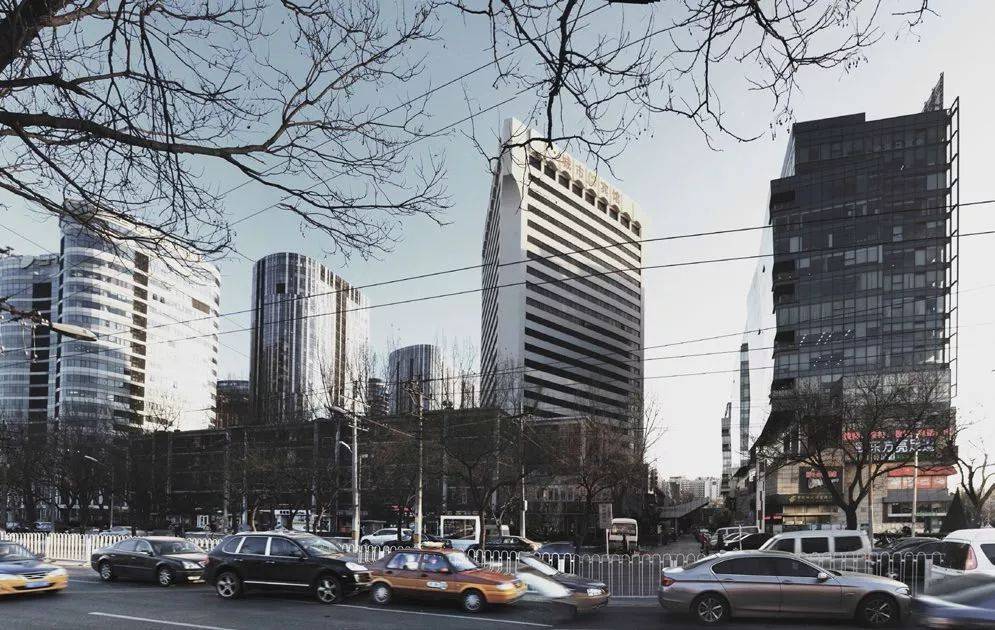
2012年北京城市宾馆原貌 ©gmp Architekten
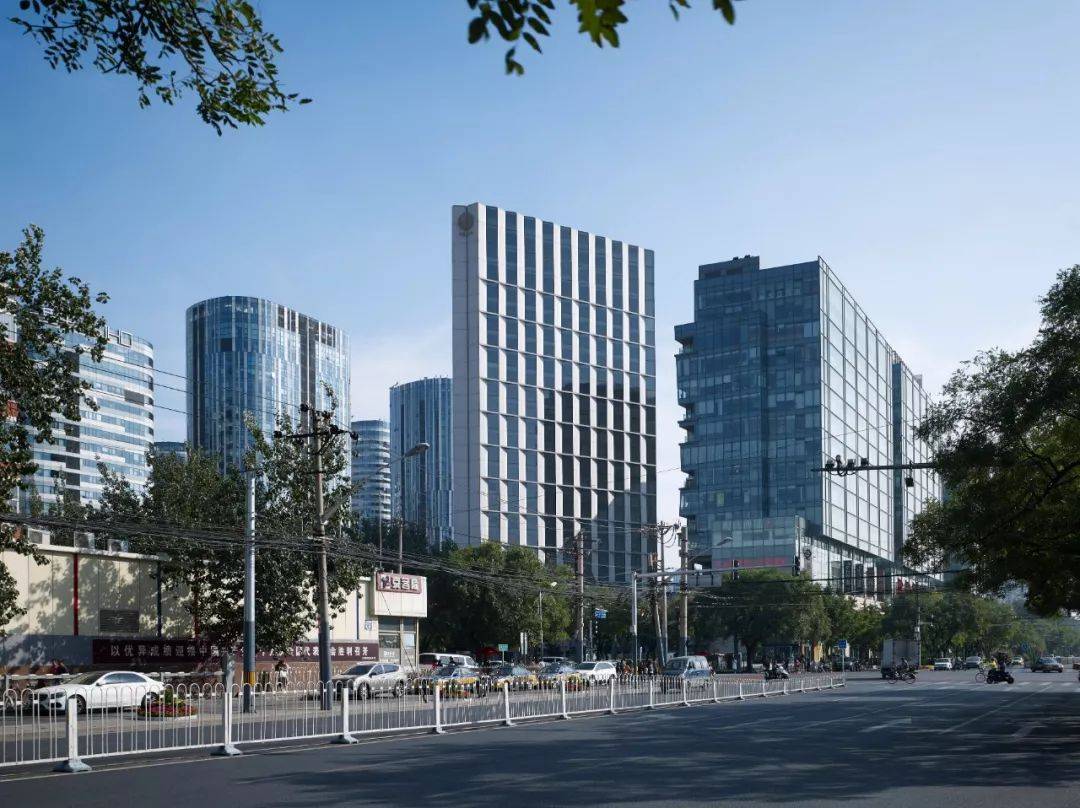
新东路塔楼西北侧立面 ©Christian Gahl
CHAO巢酒店前身是上世纪九十年代建成的“北京城市饭店”,它的外形与城市环境异质冲突是北京快速城市化进程的历史见证。gmp的立面设计旨在塑造一个具有现代性和可持续性的酒店建筑,同时重新定义塔楼在城市景观中的地位。这座80米高的酒店自2016年改造完成重新开业以来,几乎成为北京三里屯商圈最热门的目的地之一。
Since its modernization and reopening in 2016, the 80-meter-high hotel tower is one of the popular destinations in the Sanlitun business quarter of Beijing. The former “Beijing City Hotel” was created in 1990 as China began to open up. The former appearance of the building and its scant relationship with the urban design context were a result of Beijing’s fast urbanization process. The design by gmp represents a contemporary and yet long-term functional hotel architecture that reestablishes the position of the tower in the urban context.
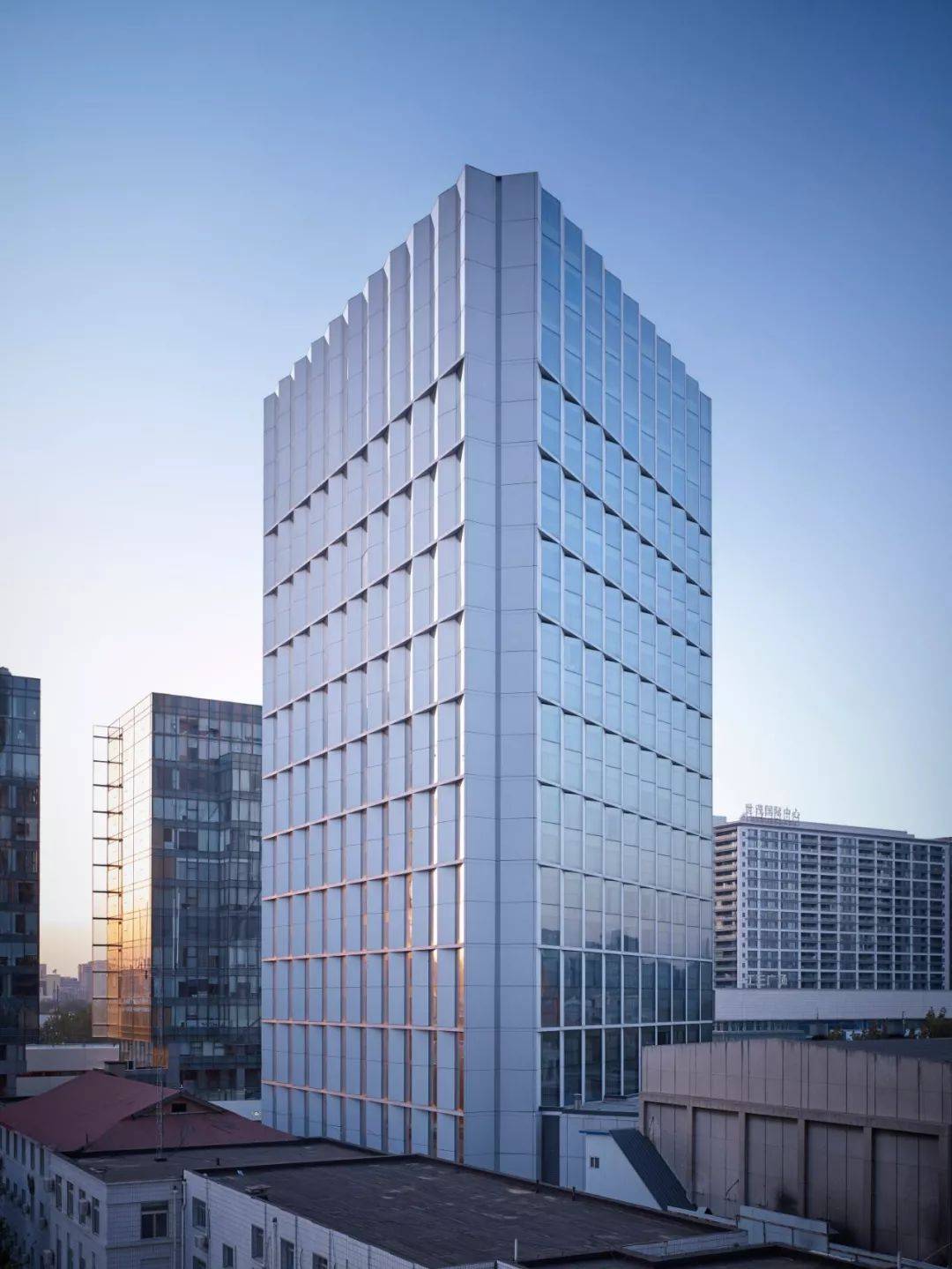
酒店塔楼东南视角 ©Christian Gahl
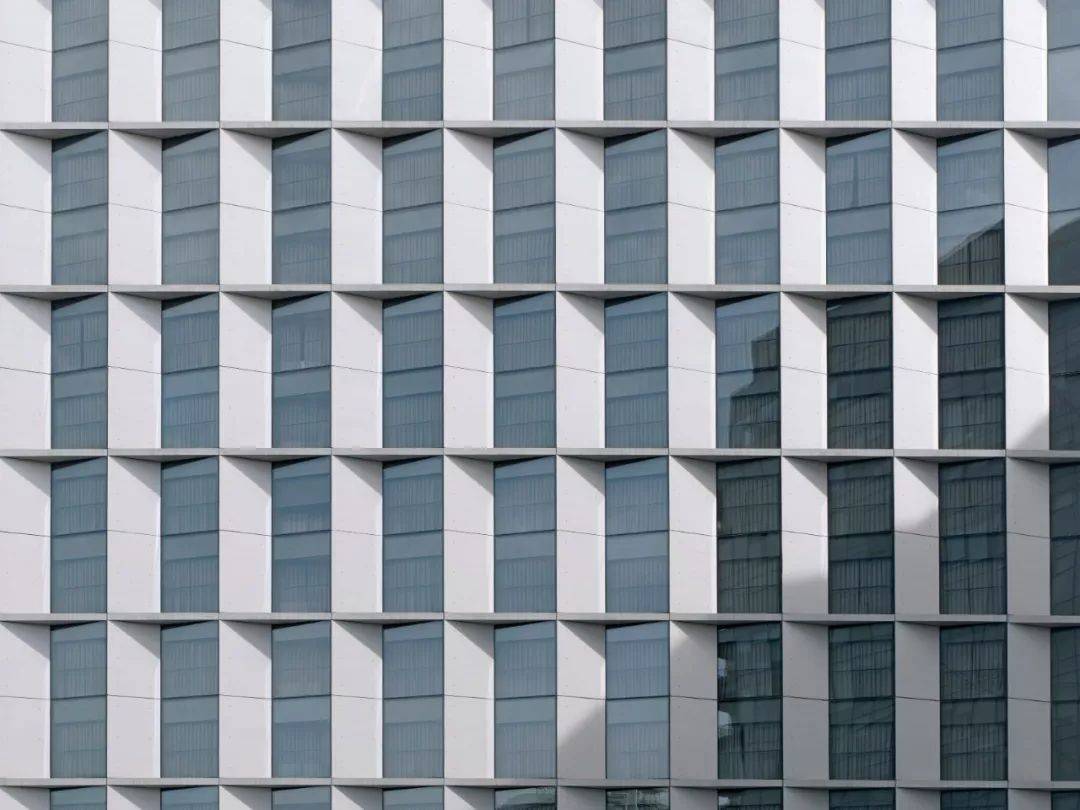
幕墙局部 ©Christian Gahl
极富识别度的折叠状幕墙包裹着26层高的塔楼,塔楼平面呈三角形。浅灰色玻璃纤维混凝土与灰色玻璃被交替悬挂布置,使得建筑的三个立面从不同角度望去都有由虚到实的变幻效果。每两层为一个单元设置纤细的横向玻璃纤维混凝土分隔,营造了和谐的立面肌理。折叠幕墙及通高的落地大窗保证客房私密性的同时在一定程度上面向城市空间开放,实现了独一无二的空间质感。
The three-dimensional zig-zag-like building envelope reflects the triangular footprint of the 26-story tower and reinforces the recognizability of the building. Curtain-wall elements in light gray glass-fiber concrete alternate with gray-tinted glass panels and the angled arrangement of these panels and elements means that, depending on the viewing angle, the sides of the building appear to change between open and closed.
Slender horizontal ledges made of glass-fiber concrete have been inserted every other story, thus creating a harmonious rhythmic division of the facade. The geometric arrangement and the story-high glazing opens the formerly introverted building to the surrounding urban space and creates a new spatial quality in the hotel rooms.
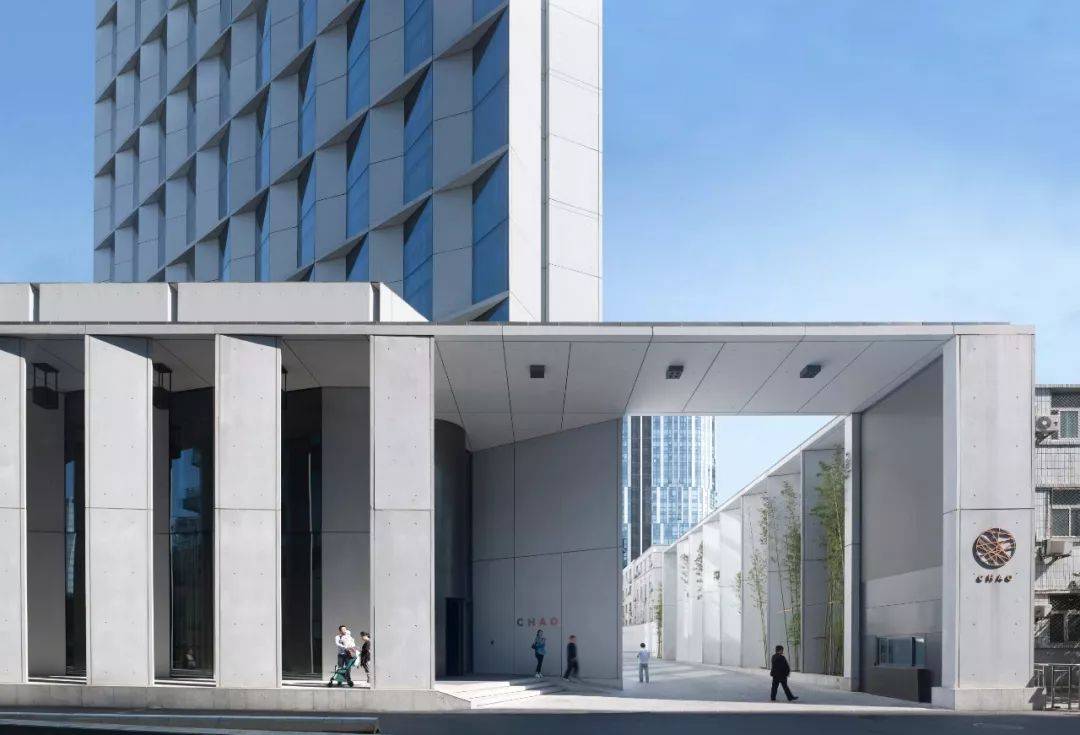
柱廊及酒店入口 ©Christian Gahl
塔楼立面的材料和结构逻辑也延续到了酒店扩建出的入口区域。与幕墙相同的玻璃纤维混凝土饰面板构成10米高柱廊在建筑的西侧和南侧限定出入口空间,同时在南侧围合出半开放庭院。原本酒店的入口较为隐蔽,垂直饰面板以不同的角度扭转,直观地将酒店客人由繁忙的工人体育场北路引导至酒店入口。
The materials and structure of the high-rise facade continue in the new extended entrance area of the hotel. A colonnade on the west and south sides of the building consisting of ten-meter-high glass-fiber concrete elements visually defines the entrance and screens the semi-public forecourt to the south of the hotel. The vertical panels with triangular cross-sections are positioned at different angles, which has the effect of guiding hotel guests intuitively from the noisy Workers’ Stadium North Road to the recessed, formerly very hidden, hotel entrance.
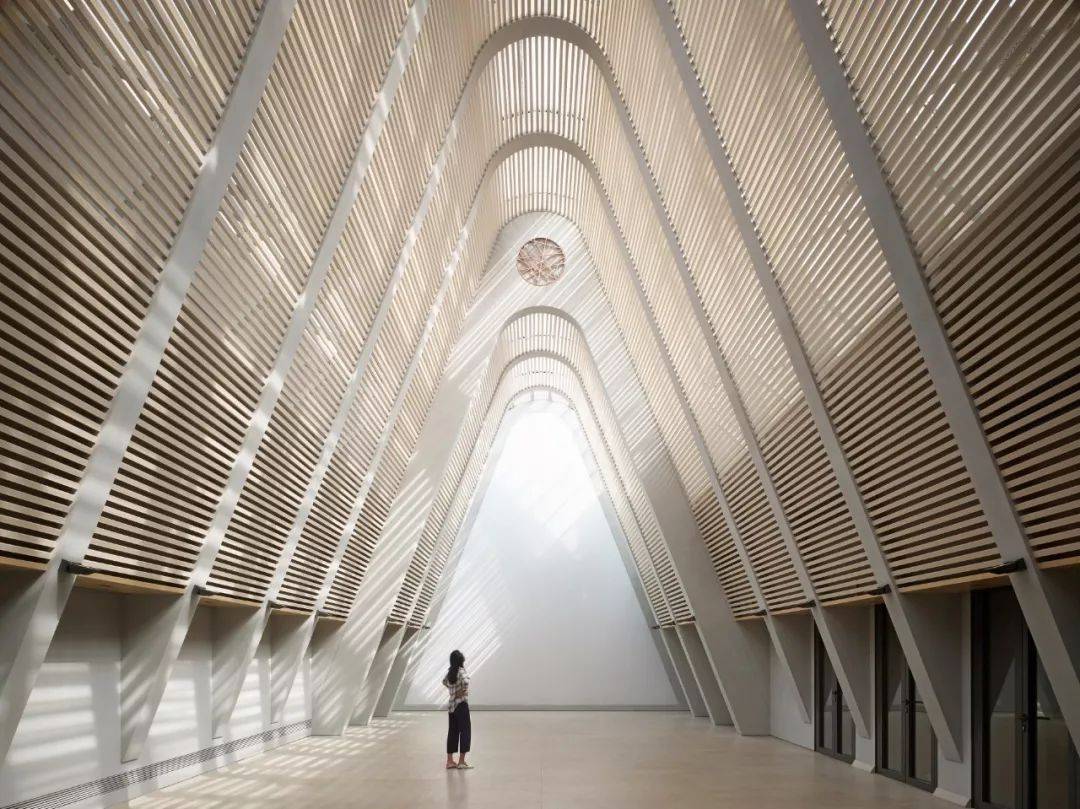
日光礼堂内景 ©Christian Gahl
同样由gmp改造设计的日光礼堂也沿用了立面设计的清晰逻辑。拱形结构支撑起一座双层屋顶,外层为玻璃顶盖,日光通过内层格栅衍射进入大厅,空间由此得名“日光礼堂”。格栅具有防晒、削弱直射光线以及吸收噪音等功能。混凝土拱顶与木质格栅的组合呈现出富有戏剧性的光影效果,强调了空间结构沉静的力量感和庄严的氛围。
Likewise, the venue modernized by gmp and now called “Glasshouse” reflects the clear geometry of the facade design. Supported by an arched structure, a double-skin roof with an external layer of glazing and internal louvers admits daylight into the space below, which has aptly been named “Glasshouse”. The louvers function as solar screening devices, softening the natural light, and as a means of attenuating sound. The interplay of colors of the concrete arches and wooden louvers in combination with the play of light and shadow create a nearly spiritual atmosphere in the space below.
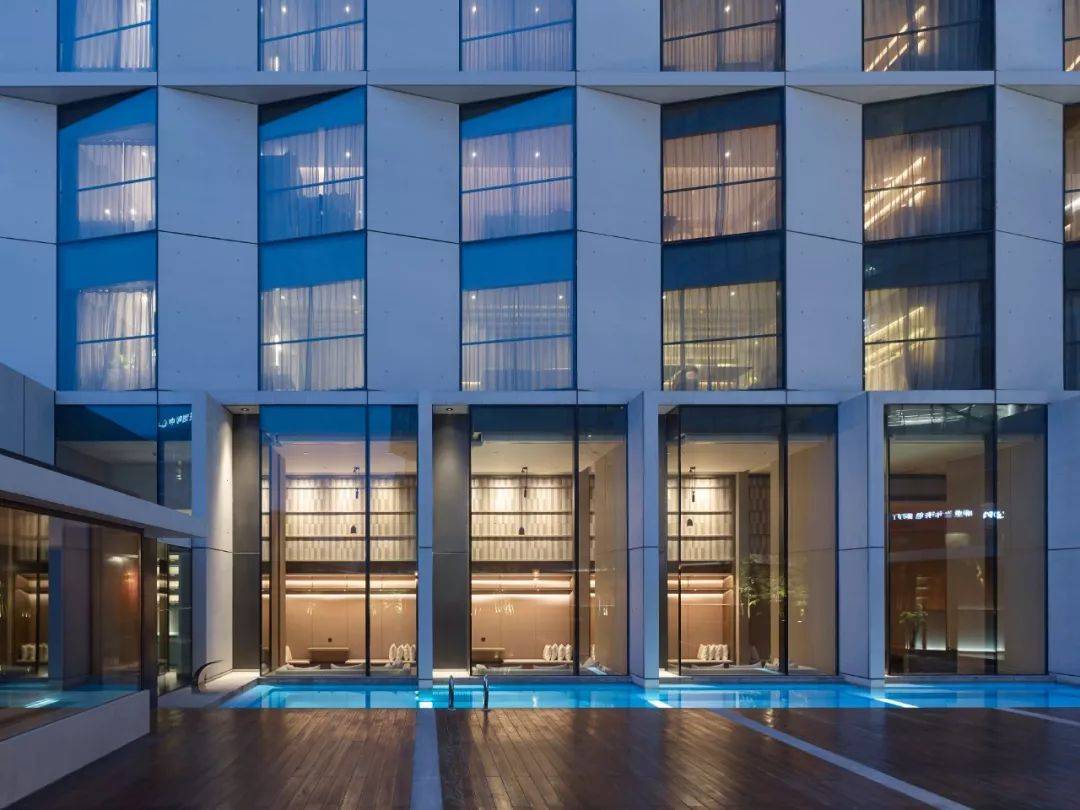
内庭院中泳池和西北侧幕墙 ©Christian Gahl
-
项目信息
设计委托:2012年
设计:曼哈德·冯·格康和施特凡·胥茨,以及施特凡·瑞沃勒
项目负责人:苏俊
设计团队:刘虓,肖闻达,杨莹,林达,丁乔,周一晗
中国项目管理:李凌,解芳
结构设计和空调设计:北京市建筑设计研究院有限公司
幕墙咨询:德国华纳工程咨询有限公司
室内设计:北京花旗建设有限公司,gmp
业主:CHAO酒店
建筑面积:31372平方米
发文编辑|Aaron
审核编辑 | Miranda
版权©建道筑格ArchiDogs,转载请联系media@archidogs.com
若有涉及任何版权问题,请联系media@archidogs.com,我们将尽快妥善处理。

